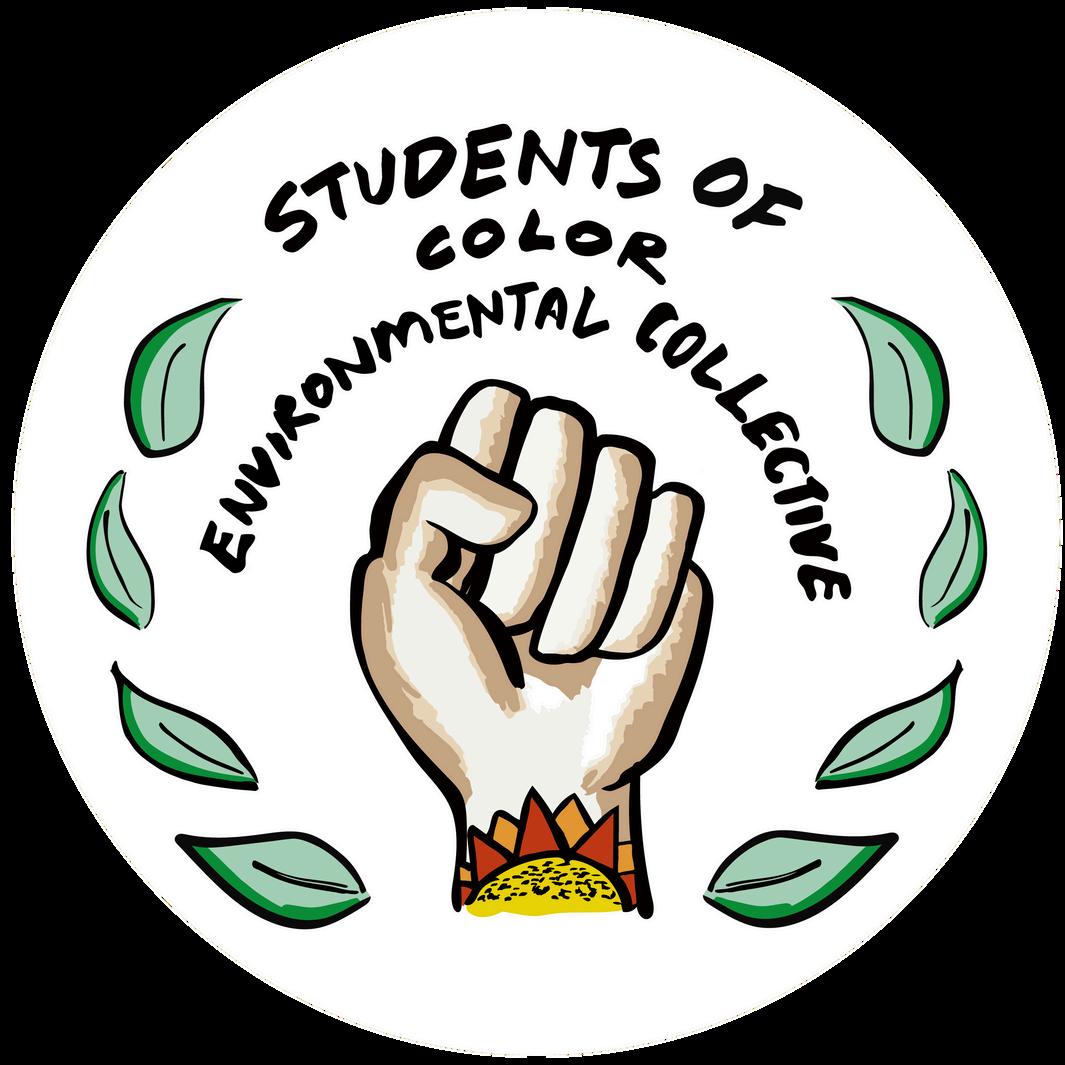












OA Student Publication


























OA Student Publication












Managing Editors
Alexandra Jade Garcia
Jacqueline Canchola-Martinez
Art & Design Leads
Armando Gutierrez
Jessalyn Fong
Jacqueline Canchola-Martinez
OUR CONTRIBUTORS
Angie Chen
Angie (she/they) is a second year student from South Florida (and later the South Bay) studying Environmental Economics & Policy, Society and the Environment, and minoring in Sustainable Business and Policy She is passionate about the role of neoliberalism and capitalism in environmental and social marginalization and degradation She's also passionate about centering marginalized voices in fantasy books!
Krishna Parekh
Krishna (she/they) is a fourth year from LA County studying Environmental Science and History. They are passionate about ecology, conservation, Palestinian liberation, and reading She is currently writing a thesis about habitat restoration and its effects on biodiversity, and a comparative thesis about colonial hunting practices in British India and British East Africa
Sydney Lee
Syd (she/they) is a third year from Los Angeles studying Society and Environment with a minor in City Planning. They are passionate about food systems and agriculture as a way to analyze human health and well-being.



Kavina Peters
Kavina (she/her) is a third year studying Environmental Economics and Policy with a minor in Food Systems She is passionate about decolonizing narratives around agriculture, and is currently working on a project to incentivize regenerative agricultural practices
Zora Uyeda-Hale
Zora Uyeda-Hale (she/her) is a passionate leader, activist, and creative from Albany, California She is a second-year at UC Berkeley, double majoring in Society & Environment and Ethnic Studies. Zora strives to use storytelling, artivism, and culture to spark community-informed change.
Mia Soumbasakis
Mia Soumbasakis (they/them) is a 2nd year Ethnic Studies major, avid bird photographer, and activist with the League of Filipino Students They fight for national democracy in the Philippines, the death of US imperialism, and for land to be returned to their rightful indigenous owners across the globe! Makibaka, Huwag Matakot, Free Palestine!
Jacqueline Canchola-Martinez
Jacqueline Canchola-Martinez (she/her/ella) is a geographer, environmental promotora, reader, and artist from the California San Joaquin Valley Her majors are Conservation & Resource Studies and Geography and she is deeply passionate about the politics of place, social movement studies, decolonial environmental perspectives, and community care.
Alexandra Jade Garcia
Alexandra Jade (she/her) is a fourth year from the Bay Area studying Society & Environment with a minor in Political Economy Her environmentalism is shaped by community organizing efforts, student activism, and feminist frameworks on environmental justice
Jed Lee

Jessica Arenas
Jessica (she/they) is a third year from Chula Vista studying Public Health After undergrad, they plan on becoming a physician and organizing with other medical professionals to provide free healthcare access to under-resourced communities in the San Diego region
Jed Terrence Lee 李家誠 is an activist, artist, and filmmaker of the Chinese Diaspora from the Bay Area in California Jed organizes for the Student Environmental Resource Center at UC Berkeley, their alma mater, as a Wellness and Environmental Justice Community Engagement Manager to continue pursuing environmental, climate, and development justice Jed strongly believes that we can always look to nature to find inspiration for our interpersonal relationships, collective movements, and personal healing, and that there is always love, life and hope in this world. Jed is a proud alumni of SCEC and so proud of the work SCEC carries on through #OE!
Shreya Chaudhuri
Shreya (she/her) is a third year undergrad student from the Bay Area studying Environmental Science & Geography with minors in Data Science and Global Poverty + Practice She is deeply passionate about Traditional Ecological Knowledge and Indigenous sciences around the world She facilitates the DeCal: Decolonizing Environmentalism and runs Project Planet, a non-profit about creating decolonial environmental educational content
Megan Mehta
Megan Mehta (she/her) is a third year undergraduate from the East Bay Area studying Data Science (Applied Math & Modeling Concentration) and Society & Environment (Global Environmental Politics Concentration). She works to utilize data science, machine learning, and policy analysis principles in climate change research to help build a greener future. She is a zealous supporter of decentralized clean energy-based electric grids, and hopes to continue to research sustainable water infrastructure, deforestation, natural resource management, and agroecology.
Jessalyn Fong
Jessalyn (she/her) is a third year from San Diego, California studying Conservation and Resource Studies with a minor in Human Rights. With a concentration in "Environmental Justice Law & Advocacy," she is driven by a passion to explore how policy and law can serve as effective tools for promoting environmental justice and amplifying the voices and experiences of BIPOC communities
In 2017, the Students of Color Environmental Collective (SCEC) at UC Berkeley held a demonstration in Mulford Hall of the College of Natural Resources. Standing in front of photographs of mostly White faculty in the college, students asked, "Where are the Professors of Color?" This demonstration was part of SCEC’s #EnvironmentalismSoWhite campaign, a movement that sought to challenge the racist roots and praxis of the environmental movement and reclaim environmentalism for people of color. Campus environmentalism could no longer freely ignore or suppress our voices and experiences. The #OurEnvironmentalism campaign is rooted in this same radical spirit. Rather than try to fit ourselves into the traditional mold of (White) environmentalism, we are instead redefining what it means to be an advocate for so-called nature, telling our stories, and creating space for ourselves and those students who will come after us.


OurEnvironmentalism is part of this #OE campaign and is a first-ofits-kind publication made by BIPOC environmental students at UC Berkeley. While as undergraduate students we typically spend hours of our semesters writing papers, doing research, and completing academic deliverables for courses, these works typically go unseen after being submitted for grades at the end of the semester. In an effort to uplift our rich academic work, specifically as BIPOC environmental students, we have created this academic journal. Also part magazine and part zine, you’ll find that our approach transcends any easy label and that this first volume is a sweeping one.
Our theme, “all of us: Radically Imagining Past, Present, and Environmental Futures”, is purposefully wide and airy, emphasizing that the
“all” in so many spaces, whether it be environmental history, the environmental movement, or elite academic institutions, has not meant “us”: Black, Indigenous, and People of Color. These works, from poems to photographs, policy briefs to research essays, voice the critical and beautiful lenses through which we, as environmentalists of color, see the world.
PAST examines those legacies that are colonial, imperial, and White supremacist and how they reverberate in today’s world. PRESENT examines the current crises that weigh heavy on our hearts, from the ongoing genocide of Palestinians to the slow violence inflicted on our communities here in California, as well as examples of resistance and personal reflection. FUTURE asks what it would look like to dismantle our systemic enemies racism, colonialism, neoliberalism, and dualisms—while peering into other worlds and possibilities.
We’d like to thank and celebrate every single contributor to this volume. May rage, inspiration, and a profound sense of hope flow through you as you read their works. Thank you to the Green Initiative Fund (TGIF) for funding the #OurEnvironmentalism project. And, of course, thank you to the Student Environmental Resource Center for believing in and supporting this publication since the beginning.
With love and in solidarity,



Becoming a “Wasteful American” by Kavina
Mother, Mother by Zora
Implicating the Epidemic of Burnout in the Collective “War Against Imagination” by Jed Lee......................................63
“Pani:” Case Studies of the Jalanidhi Project and Jal Jeevan Mission for Water Infrastructure Development in India by Megan Mehta.................................................71
Environmental Degradation as a Consequence of Neoliberalism by Angie Chen..................................................77 Indigenous Rights to the Land and Narratives of Western Science: An Environmental Politics Case Study of Mauna Kea and the Thirty Meter Telescope by Meg Kalaw......................................81

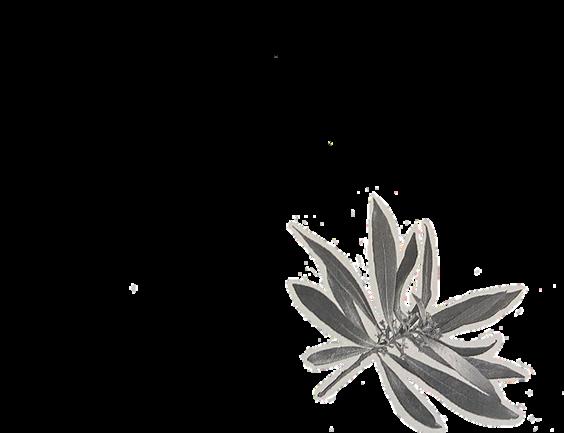

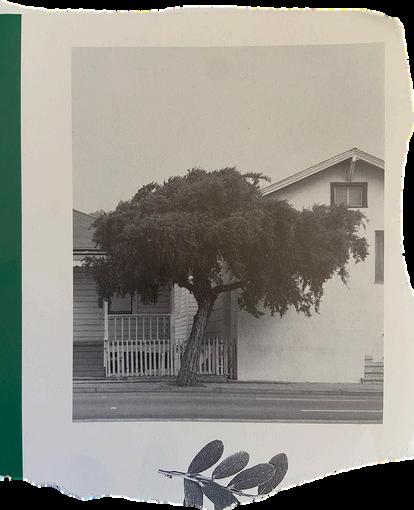



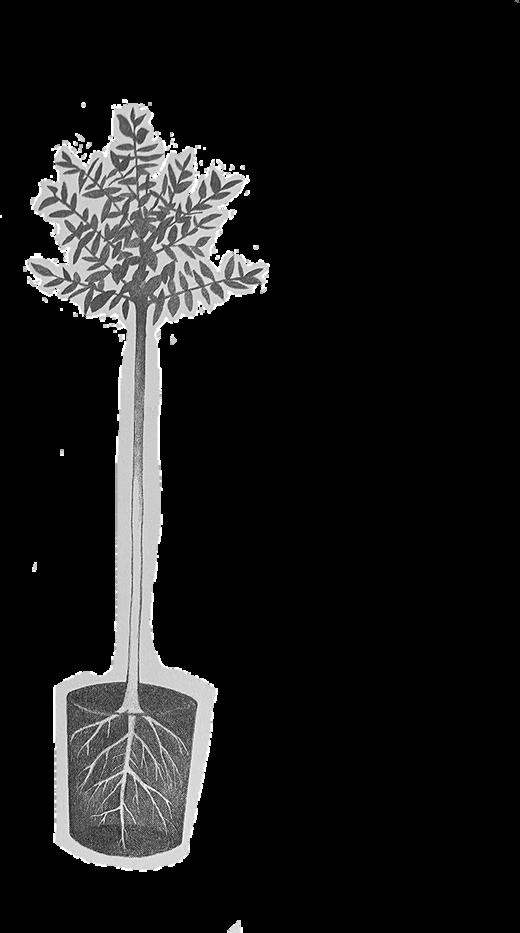





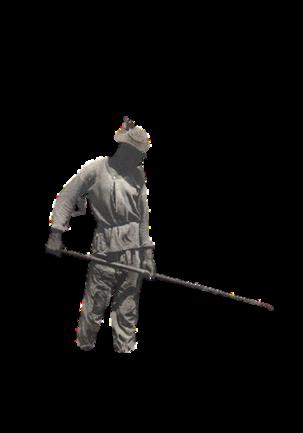






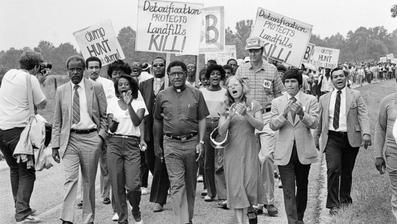


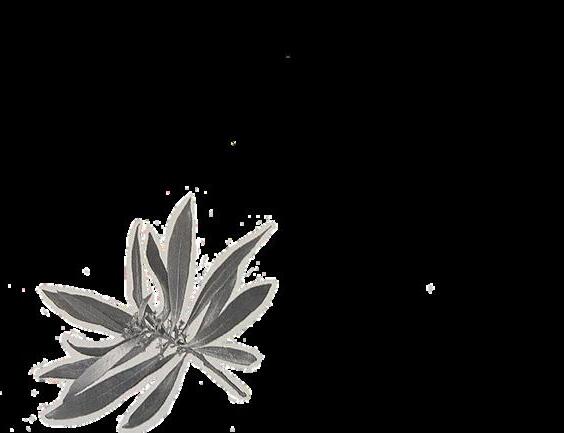
“Whether we want to or not, we are traveling in a spiral, we are creating something new from what is gone.”
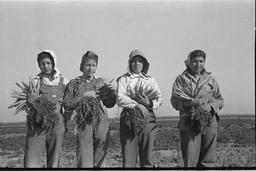

- Ocean Vuong





Immigration policy in the 18th and early 19th centuries remained lax until large waves of immigrants moved to the US in search of employment or to evade increasingly unstable home environments. In 1790, the Nationality Act outlined eligibility for citizenship and defined eligibility rights as applying to “free white persons”, excluding non white people. This restriction was in place until 1952 and numerous legal decisions were based upon this precedent. Exclusion acts reinforced the narrative that immigrants were stealing jobs from white Americans and made white population purity a conscious goal for legislators and citizens In 1911, over 400,000 Japanese Americans lived in the states and primarily settled in Hawaii and California. Geopolitical tensions between Japan and the U.S. were used to justify land grabs based on eligibility for citizenship that had been set in 1790 The 1913 and 1920 Alien Land Laws along with formal Japanese internment in 1942 are responsible for the setback of Asian food sovereignty within the United States as land was forcibly handed over to white farmers and commercial agriculture. The loss of Asian American farming businesses due to legal discrimination on the basis of aliens ineligible to citizenship laws has displaced them from farming livelihoods, making cultural foods less accessible.
There has been a longstanding narrative that immigrants have been stealing white Americans’ jobs The logic most commonly employed is that if an immigrant did not hold that job, then someone else (presumably born in the US) would be able to have work. The lump of labor fallacy assumes there is a “fixed amount of work to be done” 1 . Assuming a fixed amount of labor implies that no new jobs are being created but that there is only redistribution During the 1950s, 33% of the labor within San Francisco was completed by Chinese men, making it easy for Americans to point out and criticize immigration as the source of unemployment. The Page Act of 1975, more commonly referred to as the Chinese Exclusion Act, barred laborers from “China, Japan or any Oriental country” 2 from entering. The exclusion of people from “any Oriental country” created a clear distinction and disdain for non-west cultures and identities 3 which later manifested itself in various education and work policies
I. IntroductionAs the Japanese population increased, antiJapanese sentiment developed similarly to the way it impacted Chinese populations. In 1906, the San Francisco school board mandated that Japanese and Korean students must attend “Oriental school” with the already separate Chinese student population This separation and intense ‘othering’ of Asian populations illustrates the resistance towards a diversifying population. Exclusion policies had formally established western superiority over unfamiliar eastern culture and framed its people to be a threat to American society and the American economy
Japanese immigrants entered America at the bottom of the economic ladder and had to find a means to survive and establish themselves Families gravitated towards farming and agriculture for economic stability since there was prevalent backlash against Asian immigrants in other labor markets. Shifting to agriculture was thought to reject the takeover and job theft narrative that had contributed to anti-Asian sentiments In addition, cultivation was a vessel for cultural and community preservation.
Over time, Japanese farmers turned their small acreage into some of the most productive and fertile farmlands. Their presence was most notable in the California agricultural scene, with 39% of California farms being operated by Nikkei 4 farmers 5 . The average value per acre of all farms was $37.94 and Japanese-owned farms were valued at $279.96 6 . At that same time, Japanese-owned farms were responsible for cultivating 35 to 50 percent of vegetables in California, which constituted to being “between one-to two-thirds of the county’s vegetable production” 7.
The increased amount of land held by Japanese farmers was perceived to foreshadow a total takeover. The concern around a growing foreign population was rooted in preserving white racial purity During the time, progressives in California connected economic self-preservation to racial preservation. Therefore, witnessing the success of Japanese farms fostered the belief that “it would only be a matter of time before they would make racial inroads” 8 . Progressives of the Republican party in California, such as Chester Rowell, were specifically worried about “Japanese immigrants taking over much of the state’s agricultural land” 9 and expressed interest in preventing these perceived outcomes.
The concern over white Americans losing land was a heavily discussed topic for California legislators

“Over time, Japanese farmers turned their small acreage into some of the most productive and fertile farmlands. Their presence was most notable in the California agricultural scene, with 39% of California farms being operated by Nikkei farmers . ”
between 1907 and 1913. The “emotional pleas of [white] farmers stole the show” 10 at town halls and highlighted the specific concern over white farmers’ prosperity as a reason to deny Japanese immigrants land ownership In 1913, the Alien Land Act was passed and effectively targeted “aliens ineligible to citizenship” 11 . This intentional phrasing targeted Asian immigrants from owning land. In 1913, when the bill was introduced, only Caucasians or people of African descent were allowed to naturalize into the United States It specified that aliens “eligible to citizenship” were able to own land which “effectively prohibited Japanese and a few other Asian residents in the state from doing the same” 12 . An attempt to remedy this denial of land ownership was by allowing ineligible aliens to lease land for up to three years The three-year lease limitation made it difficult for Japanese families to solidify themselves in the agricultural scene by establishing multigenerational farms. Families began to set up joint operations, where multiple families cooperatively operated land. This would allow families to pass the land lease between each other to maintain longevity and claim to their land In 1920, Japanese Americans held their peak amount of land at 458,056 acres. Therefore, American-born children were barred from leasing land as well. Asian Americans were therefore not able to lease, own, or control land in California It was also extended to prevent Asian corporations or businesses from owning land, extending land laws beyond fields. Two years later, 330,653 acres of land were held 13 . The 1920 land laws strategically prevented Asian and Asian Americans from owning agricultural or commercial land in California
On February 19, 1942, Executive Order 9066 was enacted and removed Japanese immigrants and
Americans of Japanese descent from the West Coast after Pearl Harbor was attacked. The attack on Pearl Harbor coupled with building concerns over economic competition and non-white population growth quickly spurred on relocation Executive Order 9066 did not explicitly name Japanese populations, however, John L DeWitt explicitly enforced a curfew for Japanese Americans. From there, DeWitt verbalized support for Japanese Americans to voluntarily leave but only 7% of the population did so. Later, on March 29, 1942, DeWitt enforced Public Proclamation No 4 which forced the removal of Japanese-Americans from the West Coast within only 48 hours. The Food for Freedom Program reassured Americans that they would not fall short on their harvests during wartime and boasted that “America has the best informed farmer and the best agricultural leadership” 14 All the while, Japanese-operated farms were the ones yielding 35-50% of the county’s vegetable harvest.
The 1790 Nationality Act created the classification of “aliens ineligible for citizenship” that targeted Asian immigrants’ rights to property ownership and employment. The law exclusively outlined “free white men” as those being eligible during an era where race was viewed in a black-white paradigm Asian immigrants were deemed to be nonwhite and therefore ineligible to citizenship. This status-race perspective utilizes a “common sense” rationale to determine where people stand socially and economically 15 relative to each other Status-race rationale uses race as a comparative measure and thus creates an inferior-superior dualism. The usage of status-race emphasizes the racial hierarchy and shows how inferiority ends up limiting one’s access to social, economic, and political resources. Whiteness, as
defined in the 1790 law, operates as an identity that has various privileges aligned with it. Apart of these privileges are property rights, or “legal entitlements [that] arise from that status” 16 Cheryl Harris argues that property is a right rather than a physical or tangible asset 17 . She argues that property entails “all of a person’s legal rights” 18 . Therefore, one’s racial status determines their ability to own any properties. Value and freedom have always been adjacent to whiteness As mentioned earlier, only whites or those of African descent were allowed to naturalize, showing that the “aliens ineligible for citizenship” phrasing of the land laws was intentionally attacking Asian immigrants and their attempt to stabilize themselves through agriculture

B. The Alien Land Laws were Designed to Shift Asian-owned Land into White Hands
The sociolegal construction of property allowed for race-based land laws to develop and actively shift Asian-owned land to white farmers and operations
The support to pass the Alien Land Laws initially in 1913 was rooted in the interest to preserve white farmers’ economic endeavors. This success occurred at a time when the US President had shared concern over creating a “homogenous population out of people who do not blend with the Caucasian race ” 19 Since white economic stability was tied to racial purity, it was imperative to Progressives that the economic sector remain in control of white citizens. The fruitful success on Japanese farms was thought to have deeper implications for overall racial success that would bleed into their obtaining of other rights The land laws were a clear attempt to prevent this from happening
“ Value and freedom have always been adjacent to whiteness.”
The restructuring of the land laws in 1920 to prevent Asian Americans from even leasing land shows that even those born in the states are only viewed as foreigners. The legal and social norms surrounding Asian identities are reduced to a foreign, immigrant status 20 This race-based legal discrimination provided the foundation for the full restriction of Asian property rights in 1920. Around two decades later in 1940, there were 125,928 white farm operators and only 6,730 nonwhite operators in California. White operators ran 30,168,554 acres of farmland while nonwhite farmers ran 355,770 acres 21 , showing an aggressive loss resulting from the land laws. The census’ separation of white and nonwhite operators also depicts the distinction of race within data points, contributing to the concept of “othering”. The “nonwhite” category doesn’t break down into more specific racial categories but still shows the shift in land ownership throughout the country. Most new
andowners were “naturalized European immigrants, or Americans from the Dust Bowl region” 22 This was an intentional effort to ensure land remained in white hands.
By the time internment ended in 1946, many Japanese families left California or failed to return to their farmland. Their exclusion from the West Coast forced them to give up their source of income and cut their history in US agriculture short Fear of social discrimination and violence prevented people from returning. Sugimoto, an archivist, states that “After the war, very few farmers came back” and that “People had to restart their lives” 23 . Beyond social exclusion and potential violence, they were still unable to own any property, as the land laws did not end until 1952
By the time the land laws were repealed, it was hard for Japanese farmers to reenter the agricultural scene, let alone compete with white farmers and new agribusinesses that have developed. The term “agribusiness” was first used in 1955 to describe a massive conglomerate of operations that controlled both the production and distribution of food 24 These businesses dictated the price that their produce could be sold at and have eliminated the communal aspect that farming has had since the beginning of time. This vertical integration made it nearly impossible for independent farmers to compete
The networks that Japanese farmers had previously maintained prior to internment were shattered. There was no land to return to and starting over was too risky both socially and economically.
They had previously utilized “ethnic networks” 25 grow and transport produce, thus demonstrating some level of food sovereignty. Before the land laws and internment, Japanese farmers had control over what they grew and who it could be distributed to. They grew and shared a wide variety of fruits and vegetables throughout their networks and their farms were a source of social and economic value
The hundreds of thousands of acres that were operated by Japanese farmers became backyard gardens. Those passionate about farming were able to enhance their land on a comparatively smaller scale for themselves and their neighbors Kiyoko Nakatsui’s family writes that the farm was just a memory of their early years in the states. Her family was unable to return to their land after their means of social reproduction and economic stability were shattered. Despite this, they still cultivated an abundant garden that grows their favorite fruits and vegetables every season The persimmons, kumquats and avocados are better than store bought, as her family knows how to be patient with the natural growing cycles and tend to their plot. The families all share their harvests with one another, emulating the heart of food sovereignty connections on a smaller scale
Food is commonly referred to as one of the most powerful vessels of cultural preservation. Cultural values can be relayed through food access and cultivation. To challenge a group’s agricultural efforts is to suppress their culture. Food sovereignty advocates emphasize the importance of cultural ingredients that are cultivated and enjoyed locally Cultural foods in many supermarkets throughout the country are found in a single aisle. These ingredients must be bought at specific grocery markets that import ingredients from home countries abroad. There is no diverse food network within the United States that is as reflective of the diversity of its population Food is no longer grown based on local need or capacity. Our systems have become a one-size-fits-all model that hastens natural growing processes in search of profits and is reliant on globalized networks. It is nearly impossible to trace back the various sources and stages that our food is channeled through in its lifetime. The homogenized food system within America is due to the prevention of diverse bodies from cultivating the land and the subsidizing of large agribusinesses.
The widespread belief that Asian communities were stealing white populations’ economic opportunities led to the enactment of Anti-Asian land laws The social construction of property rights and race-based rationale paints Asians as non white foreigners, preventing them from exercising social and legal mobility. Even though Japanese farmers were able to successfully work with the land, their economic contributions came secondary to racial purity Additionally, the social and physical othering of Japanese communities during internment actively removed them from their farmland in an era where agricultural mechanization and homogenization took flight. After internment, it was near impossible to restart their farming initiatives under growing social and economic burdens. The social deterioration of Japanese farm networks through race-based rationales has directly setback and prevented a diverse and local agricultural scene in California
9.
Van Nuys, Frank “A Progressive Confronts the Race Question : Chester Rowell, the California Alien Land Act of 1913, and the Contradictions of Early Twentieth-Century Racial Thought” (2)
10.
11.
12.
13
14
Van Nuys, Frank (4)
Immigration History, “Alien Land Laws in California (1913 & 1920)” 2019
Van Nuys, Frank (5)
Yuji Ichioka, “Japanese Immigrant Response to the 1920 California Alien Land Law” Agricultural History, Vol 58, No 2 (Apr 1984) pp 169
United States Department of Agriculture, “Food for Freedom”, 1943 https://naldc.nal.usda.gov/download/1789419/PDF
15.
16.
17.
18.
19.
20
Neil Gotanda, “A Critique of ‘Our Constitution is Color-Blind’”, 1991 (18)
Cheryl Harris, “Whiteness as Property” Harvard Law Review, Vol. 106, No. 8, 1993, (1725)
Cheryl Harris, 1725
Cheryl Harris, 1726
Don Wolfensberger, “Woodrow Wilson, Congress and Anti-Immigrant Sentiment in America An Introductory Essay” Woodrow Wilson International Center for Scholars, 12 Mar 2007
Chang, Michael “Exclusion and the Law”, University of California, Berkeley, 9 Feb 2023
Lecture
21.
Census of Agriculture - California, State Table 1. “Farms and Farm Acreage, by Color and Tenure of Operator, and by Size of Farm 1910-1940; and Farm Land According to Use, 1924 to 1939”
22.
23.
John G. Brucato, The News, “War Hits the Farm Lands” 1948
Morino, Douglas “Preserving the Legacy of Japanese American Farms in Southern California”, The New York Times, 1 May 2023
24 Immigration History, “Alien Land Laws in California (1913 & 1920)” 2019
Bill Ganzel, “Farming in the 1950s & 60s - Agribusiness” The Ganzel Group, 2007
25

“ To challenge a group’s agricultural efforts is to suppress their culture. Food sovereignty advocates emphasize the importance of cultural ingredients that are cultivated and enjoyed locally. Cultural foods in many supermarkets throughout the country are found in a single aisle. These ingredients must be bought at specific grocery markets that import ingredients from home countries abroad. There is no diverse food network within the United States that is as reflective of the diversity of its population.”

Azuma, E. “Japanese Immigrant Farmers and California Alien Land Laws: A Study of the Walnut Grove Japanese Community ” California History, vol 73, no 1, 1 Apr 1994, pp 14–29, https://doi org/10 2307/25177396 Accessed 2 Dec 2019
Brucato, John G. War Hits the Farm Lands : City Folks Urged to Harvest Crops’ during Vacation Back-To-Land Movement Takes on a New Importance. The News, May 1998, www sfmuseum org/hist9/harvest html#:~:text=The%20World%20War%20II%20evacuation,%2 DJapanese%E2%80%9D%20owners%20and%20lessees
Chang, Michael. Exclusion and the Law. 9 Feb. 2023. Lecture given at the University of California, Berkeley.
--- Immigration Politics, Policies and Practices 2 Mar 2023 Lecture given at the University of California, Berkeley.
Chin, Gabrial J. , and Anna Ratner. “The End of California’s Anti-Asian Alien Land Law: A Case Study in Reparations and Transitional Justice ” Asian American Law Journal, vol 29, no 1, 9 Nov 2022, pp 1–17, https://doi org/10 15779/Z383775W4G
Ganzel, Bill. Farming in the 1950s & 60s. The Ganzel Group, 2007, livinghistoryfarm.org/farminginthe50s/farminginthe1950s.html.
Gotanda, Neil “A Critique of “Our Constitution Is Color-Blind ”” Stanford Law Review, vol 44, no 1, Nov. 1991, p. 1, https://doi.org/10.2307/1228940.
Harris, Cheryl I. “Whiteness as Property.” Harvard Law Review, vol. 106, no. 8, June 1993, pp. 1707–1791, https://doi org/10 2307/1341787
Ichioka, Yuji. Japanese Immigrant Response to the 1920 California Alien Land Law. Duke University Press, Apr. 1984.
Immigration History “Alien Land Laws in California (1913 & 1920) ” Immigration History, 2019, immigrationhistory org/item/alien-land-laws-in-california-1913-1920/
--. “Nationality Act of 1790.” Immigration History, 2019, immigrationhistory.org/item/1790nationality-act/.
--- “Page Law (1875) - Immigration History ” Immigration History, 2019, immigrationhistory.org/item/page-act/.
Kashima, Tetsuden. Personal Justice Denied : Report of the Commission on Wartime Relocation and Internment of Civilians Washington, D C , Civil Liberties Public Education Fund ; Seattle ; London, 1997, pp 117–134
Le Pore, Herbert P “Prelude to Prejudice: Hiram Johnson, Woodrow Wilson, and the California Alien Land Law Controversy of 1913 ” Southern California Quarterly, vol 61, no 1, Apr 1979, pp 99–110, https://doi.org/10.2307/41170813. Accessed 23 June 2020.
Mann, Alana. “Food Sovereignty: Alternatives to Failed Food and Hunger Policies.” Contemporanea, vol. 18, no. 3, 2015, pp 445–468, www jstor org/stable/24654154 Accessed 11 May 2023
Morehouse, Lisa. “Farming Behind Barbed Wire” Npr.org, 2017, www npr org/sections/thesalt/2017/02/19/515822019/farming-behind-barbed-wire-japanese-americans-rem ember-wwii-incarceration.
Morino, Douglas “Preserving the Legacy of Japanese American Farms in Southern California”, The New York Times, 1 May 2023
Nakatsui, Kiyoko “Japanese American Farming in California: A Personal History – Sherman Library and Gardens ” Thesherman.org, 27 May 2022, thesherman org/2022/05/27/japanese-american-farming-in-california-a-personal-history/ Accessed 11 May 2023.
National Archives “Executive Order 9066: Resulting in Japanese-American Internment (1942) ” National Archives, 22 Sept 2021, www.archives.gov/milestone-documents/executive-order-9066.
Quinnell, Kenneth “Asian Pacific American Heritage Month Profiles: Chinese Railroad Laborers | AFL-CIO ” Aflcio org, 9 May 2019, aflcio.org/2019/5/9/asian-pacific-american-heritage-month-profiles-chinese-railroad-laborers.
Tokunaga, Yu “Japanese Internment as an Agricultural Labor Crisis ” Southern California Quarterly, vol 101, no 1, Feb 2019, pp. 79–113, https://doi.org/10.1525/scq.2019.101.1.79. Accessed 29 Feb. 2020.
U S Census Bureau Census of Agriculture - California. 1940, agcensus library cornell edu/wp-content/uploads/1940California-STATE TABLES-1264-Table-01.pdf.
United States Department of Agriculture. Food for Freedom : Informational Handbook. 1943, naldc.nal.usda.gov/download/1789419/PDF.
Van Nuys, F. W. “A Progressive Confronts the Race Question: Chester Rowell, the California Alien Land Act of 1913, and the Contradictions of Early Twentieth-Century Racial Thought ” California History, vol 73, no 1, 1 Apr 1994, pp 2–13, https://doi org/10 2307/25177395 Accessed 11 Feb 2020
Wolfensberger, Don Woodrow Wilson, Congress and Anti-Immigrant Sentiment in America : An Introductory Essay 2007 Wolla, Scott A. “Examining the “Lump of Labor” Fallacy Using a Simple Economic Model.” Research.stlouisfed.org, Nov. 2020, research stlouisfed org/publications/page1-econ/2020/11/02/examining-the-lump-of-labor-fallacy-using-a-si mpleeconomic-model#:~:text=The%20lump%20of%20labor%20fallacy.
For ASAMST 145AC Politics, Public Policy, and Asian American Communities Prof. Michael Chang, Spring 2023
Prompt: Imagine that you are a curator in a museum, and you have been given an empty cabinet to fill. Your job is to find 4-6 objects that when placed together in that cabinet provoke questions, confound conventional wisdom, evoke telling comparisons or contrasts, or otherwise illuminate the history we've been exploring this semester. You may use any relevant object other than a simple text. Material artifacts, paintings, codexes, maps - use your imagination and aim to combine very different kinds of objects.
The story of encounter and conquest in America can be seen through the lens of Indigenous resilience and agency. The exhibit that I propose will contain art and objects from different contact zones around America and range from the period of 1510 to 1770. The exhibit will showcase Tabula Geographica Regni Chile by Alonso de Olvalle, La Virgen del Cerro Rico (The Virgin of the Mountain of Potosí), Lienzo de Tlaxcala by Anonymous, Les voyages du sieur de Champlain Xaintongeois, capitaine ordinaire pour le Roy, en la marine (The voyages of de Champlain Xaintongeouis, the ordinary captain for the King in the navy) by Samuel de Champlain, Zemi by Anonymous, and Portrait of a Mameluca Womanby Albert Eckhout. All these objects showcase how the period of European conquest
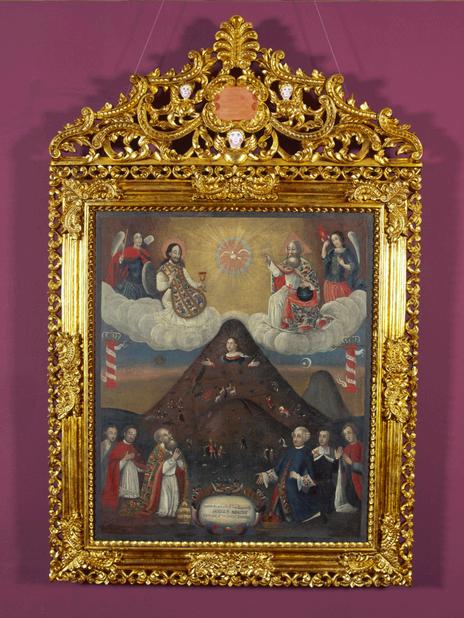
in the Americas was dominated by stories of Indigenous resilience and agency. By highlighting these stories, we can subvert the stereotypical notion that Indigenous peoples were powerless and solely the subjects of European coercion and exploitation, and we can undermine the erasure of Indigenous peoples and cultures today.
On the subject of Indigenous agency, I first turn to the Lienzo de Tlaxcala, the Les voyages du sieur de Champlain, Tabula Geographica Regni Chile, and Portrait of a Mameluca Woman. The Lienzo de Tlaxcala showcases the creation of the alliance between the Tlaxcala and the Spanish. In particular, I propose showing a depiction of the Cholula Massacre. 1 The Cholula Massacre is an example of Indigenous agency, as it was a moment in which the Tlaxcala utilized their newly founded alliance with the Spanish to enact violent retribution against an ally turned enemy Furthermore, the depiction of the Cholula Massacre will highlight how Indigenous peoples often joined in alliances with European conquerors of their own choice, often in hopes of expanding their territory or undermining their enemies. In contrast, Les voyages du sieur de Champlain is an account written and details his travels around Canada, including his interactions i h h I di l h I hat

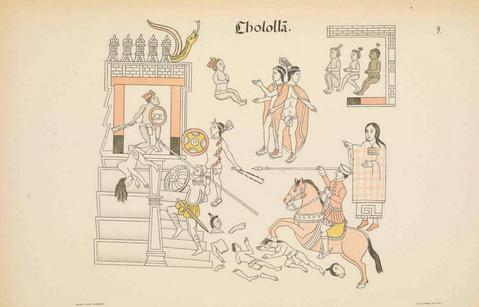
illustration by Champlain that depicts an attack by the French, and their Indigenous allies, the Anishinaabe, Wendat, and Innu, against a Haudenosaunee fort. 2 Similarly, to the Lienzo de Tlaxcala, this illustration depicts how Indigenous peoples utilized alliances with Europeans to subvert their enemies. Tabula Geographica Regni Chile is a map that was created by Fr. Alonso de Ovalle, a Chilean Jesuit. 3 The map shows the country of Chile and includes vignettes of the Parliament of Quillín which took place in 1641. The Parliament of Quillín was a meeting between the Mapuche peoples and the Spanish during the Arauco War. The Mapuche held a series of campaigns against the Spanish that eventually led to a peace treaty and recognition of the Mapuche by the Spanish crown. 4 This shows Indigenous agency, as it demonstrates an instance in which Indigenous peoples were able to form treaties with colonizing forces that recognized their sovereignty. Finally, Portrait of a Mameluca Woman depicts a mixedrace woman born of a Portuguese and Indigenous union. 5 During the colonial era in South and Central America, mixed-race marriages and children were popular.
“Lienzo de Tlaxcala” by Unknown (1550)This image highlights Indigenous agency as it portrays the Tupi concept of cunhadismo. Cunhadismo was a process in which kinship was created through the marriage of Tupi women with foreigners in their society, therefore highlighting Indigenous agency 6 Through marriage, kinship ties would be created, which effectively made the foreigner part of Tupi society. Thus, marriage was not just a way in which European men were able to create alliances with Indigenous peoples, but rather a way in which Indigenous peoples were able to make Europeans their kin and therefore subject them to the social obligations of being part of their larger family Similarly, Portrait of a Mameluca Woman is also a show of Indigenous agency during this time. By showing these illustrations, we can disrupt traditional notions that Indigenous peoples were naïve, innocent peoples who were being coerced or exploited by European conquerors This long-held belief strips Indigenous peoples of their agency, and by showing the aforementioned images, we can demonstrate how the era is much more complicated. Instead, through these images, we can see how Indigenous peoples maintained their agency in a variety of different ways
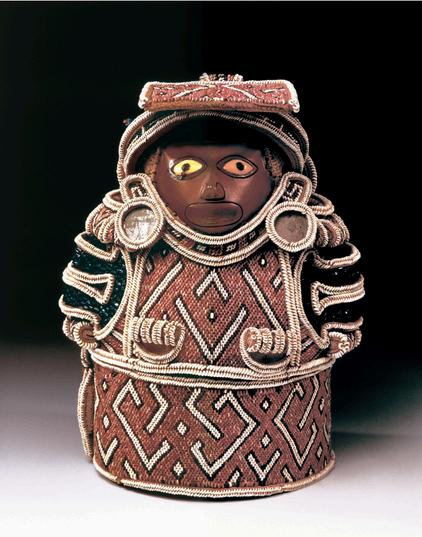

On the other hand, Indigenous resilience can be seen through La Virgen del Cerro Rico, a Zemi figure, Tabula Geographica Regni Chile, and a Portrait of a Mameluca Woman. La Virgen del Cerro Rico is a devotional image of the Virgin Mary that originates from Bolivia. 7 In Bolivia, Pachamama is a goddess that was worshipped by Indigenous peoples Associated with the Earth, mountains, fertility, and harvest, La Virgen del Cerro Rico is an example of Indigenous resilience through cultural syncretism. 8 La Virgen del Cerro Rico depicts the mountain of Potosí merged with the Virgin Mary. The depiction of the Virgin Mary as a mountain draws parallels between her and Pachamama In Latin America, the Virgin Mary was commonly used as a way to merge Indigenous beliefs with Catholicism. Thus, through cultural and religious syncretism, Indigenous beliefs and traditions were able to survive throughout colonization. Zemis were believed to be spirits or objects representing/housing spirits amongst Taíno people in the Caribbean The zemi that I propose to showcase is decorated with intricate beadwork and is likely made up of rhinoceros bone from Africa. 9 This zemi showcases Indigenous resilience in two parts. The first is that its pristine condition is reminiscent of other zemi figures that have been found in caves, as Indigenous peoples would hide them there away from Spanish colonizers who would destroy them. In addition, the use of rhinoceros bone shows how, even in an increasingly global world dominated by colonialism, Indigenous peoples exhibited resilience in keeping their cultural and religious traditions alive The depiction of the Parliament of Quillín in the Tabula Geographica Regni Chile is another example of Indigenous resilience, as
Mapuche peoples were able to resist Spanish conquest for over two hundred and fifty years, primarily through violent resistance against colonizing forces
Finally, Portrait of a Mameluca Woman shows Indigenous resilience as it pushes against the narrative that Indigenous peoples are extinct. Through identification with an Indigenous heritage, this notion of Indigenous extinction is proven false 10 All in all, through this art, we can highlight how ideas of Indigenous extinction are false; Indigenous communities were able to demonstrate their resilience through armed resistance, preservation of culture and religion, and visible indigeneity.
Overall, by showing the images that I have proposed, we can create a narrative that subverts false notions that Indigenous peoples were helpless and went extinct during the encounter and conquest era in America. By showing art that demonstrates Indigenous resilience and agency, we complicate traditional narratives about this era and provoke our audience to question what they have been told about the conquest era in America.

Lienzo de Tlaxcala, 1550, National Library of Anthropology and History, Mexico City, Mexico.
1. Les voyages du sieur de Champlain. 1613. Library and Archives Canada, Ottawa, Canada. 2. De Ovalle, Alonso. 1601. Tabula Geographica Regni Chile. Museo Nacional de Arte, La Paz, Bolivia.
3. Clément, Vincent. “Conquest, Natives, and Forest: How Did the Mapuches Succeed in Halting the Spanish Invasion of Their Land (1540–1553, Chile)?” War in History 22, no. 4 (2015): 428–47. http://www.jstor.org/stable/26098447.
4. Eckhout, Albert. 1641. Portrait of a Mameluca Woman. National Museum of Denmark, Copenhagen, Denmark.
5. Moreira, Vânia Maria. “Territorialidade, Casamentos Mistos e Política Entre Índios e Portugueses.” Revista Brasileira de História 35, no. 70 (2016): 17–39. https://doi.org/10.1590/180693472015v35n70006.
6. La Virgen del Cerro Rico. 1740. Museo Nacional de Arte, La Paz, Bolivia.
7. “Virgin of the Mountain of Potosí.” VistasGallery. Accessed April 27, 2023. https://vistasgallery.ace.fordham.edu/items/show/1924#:~:text=It%20is%20currently%20in%20the ,Arte%20in%20L a%20Paz%2C%20Bolivia.
8. Zemi. 1510. Museo Nazionale Preistorico ed Etnografico "Luigi Pigorini". 9.
For History 135B: Encounter & Conquest in Indigenous America, Prof. Brian DeLay, Spring 2023
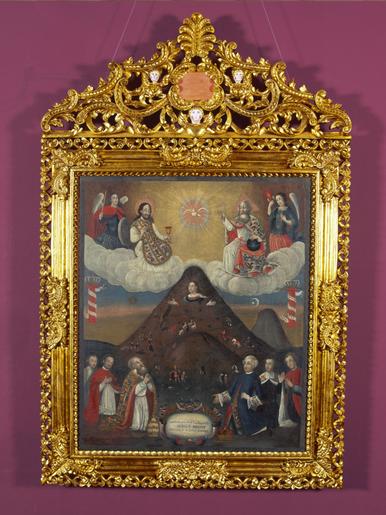
“Tabula Geographica Regni Chile” by Alonso de Olvalle (16501651), Chile, currently at John Carter Brown Library: This map was created by Alonso de Olvalle, a Chilean Jesuit priest. The map contains a compass rose, the location of rivers, settlements, the dividing line between Mapuche and Spanish territory, various wild animals, and the Spanish coat of arms. The excerpts on the map show one vignette of the Parliament of Quillín and another of warfare between Spanish and Indigenous peoples and the plans of San Jacob and Valdivia. The depiction of the Parliament of Quillín highlights Indigenous agency and resilience as it demonstrates a moment in which Indigenous peoples were able to resist Spanish colonization and were able to advocate for themselves through the creation of a peace treaty that recognized Mapuche sovereignty
“La Virgen del Cerro Rico” by Unknown (1740-1770), Bolivia, currently at Casa de Murillo in La Paz, Bolivia: This oil painting shows the Virgin of the Mountain, which is a merging of the Virgin Mary with Potosí Mountain in Bolivia. At the top of the painting is the Holy Trinity blessing Mary, and at the bottom are various saints and the artist’s patron. Climbing the mountain are mineworkers and llamas The depiction of the Virgin of the Mountain highlights Indigenous resilience, as the illustration of the Virgin Mary is reminiscent of the Indigenous goddess Pachamama who presides over fertility, mountains, and the Earth. The depiction of the Virgin of the Mountain is an example of Indigenous resilience through syncretism, in which Indigenous peoples combined elements of their religion and culture with Catholicism to keep their traditions alive.


“Lienzo de Tlaxcala” by Unknown (1550), Mexico, currently at the National Library of Anthropology and History, Mexico: The original Lienzo de Tlaxcala was commissioned by the town council of Tlaxcala Three copies were made, one for King Carlos I, another for Mexico City, and the last for the Tlaxcalan council However, all three versions were lost, and only a reproduction by Manuel de Yllánez (1773) exists. The Lienzo de Tlaxcala was created using canvas. The Lienzo de Tlaxcala shows the creation of the alliance between the Tlaxcala and the Spanish until the fall of Tenochtitlan and the end of the Triple Alliance This artwork specifically depicts the Cholula Massacre, which took place shortly after the formation of the TlaxcalanSpanish alliance. The Cholula Massacre was a moment of retribution by the Tlaxcala against the Cholulans, who had defected from their alliance to join the Triple Alliance This instance shows how Indigenous groups were able to utilize European alliances to establish dominance in the region.
“Les voyages dv sievr de Champlain Xaintongeois, capitaine ordinaire pour le Roy, en la marine Divisez en devx livres ou, Iovrnal tres-fidele des observations faites és descouuertures de la Nouuelle France: tant en la descriptiõ des terres, costes, riuieres, ports, haures, leurs hauteurs, & plusieurs declinaisons de la guide-aymant; qu ʾ en la creãce des peuples, leur superstition façon de viure & de guerroyer: enrichi de quantité de figures. Ensemble deux cartes geografiques: la premiere seruant à la nauigation, dressée selon les compas qui nordestent, sur lesquels les mariniers nauigent: lʾautre en son vray Meridien, auec ses longitudes & latitudes: à laquelle est adiousté le voyage du destroict qu ʾont trouué les Anglois, au dessus de Labrador, depuis le 53e degré de latitude, iusques au 63e en lʾ an cerchans vn chemin par le Nord, pour aller à la Chine ” By Samuel De Champlain (1613), Canada, currently at Library and Archives Canada: Samuel de Champlain was a French explorer who traveled throughout Canada This image depicts a joint attack by the French, Innu, Wendat, and Anishinaabe against a Haudenosaunee fort This artwork highlights Indigenous agency as it highlights that Indigenous alliances with Europeans were beneficial to Indigenous peoples as it allowed them to extend their dominance throughout the region, in this case through violent attacks against enemy groups

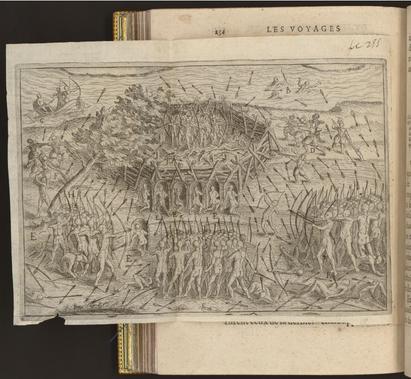
Zemi by Unknown (1510-1515), the Caribbean, currently at the National Museum of Prehistory and Ethnography “Luigi Pigorini”: In Taíno culture, zemis were believed to be both spirits and objects housing spirits This zemi is made of rhinoceros horn from Africa and decorated with Caribbean shells that are woven into a pattern Many zemis were found hidden in caves, away from European colonizers who wanted to destroy pre-Colombian religions This figure shows Indigenous resilience, one through its immaculate condition and its survival until the present, and because the use of rhinoceros horn shows how, in the face of increased European influences in Taíno culture, Indigenous peoples were still able to keep their cultural and religious traditions alive
“Portrait of a Mameluca Woman” by Albert Eckhout (1641), Brazil, currently at the National Museum of Denmark in Copenhagen, Denmark: Albert Eckhout was a Dutch painter who lived in Dutch Brazil for some time This is an oil painting on canvas. The painting depicts a mixedrace woman of European and Indigenous heritage. Other elements include a guinea pig, a basket of flowers, and a variety of greenery. This image shows both Indigenous agency and resilience Indigenous agency is depicted here as mixed-race unions that benefitted both Indigenous peoples and Europeans In Brazil, the concept of cunhadismo in Tupi culture is the giving away of a woman to strangers or foreigners to create kinship ties. Through the newly created kinship, Indigenous groups could subject Europeans to societal obligations. By forging these bonds with Europeans, Indigenous groups displayed agency Indigenous resilience is depicted in the mere visualization of a woman with Indigenous heritage, contradicting the idea that Indigenous people are extinct.


Caption: Runit Dome with Protestors Source: @sanna6789998212 on X
While the Oscar-award-winning film Oppenheimer may shed light on America's nuclear testing history, we must recognize and go beyond the surface of the overlooked and ongoing injustices inflicted upon vulnerable communities by these reckless experiments. Often untold, the Marshall Islands serve as a key example of the devastating nuclear legacy of the U S
The Marshall Islands is situated between Hawaii and Australia, consisting of two chains of 29 coral atolls. Marshallese people have inhabited the Marshall Islands
since the second millennium BCE, building a rich cultural and historical tapestry interwoven with the islands’ ecosystems In the 20th century, Marshallese people began to experience the detrimental impacts of military occupation as the Japanese came in 1914, followed by the U.S. in 1944.
From 1946-1958, the U.S. used the Marshall Islands as a testing ground for 67 nuclear weapon tests, leaving widespread contamination of nuclear fallout across the islands. Operation Crossroads was the first testing series deployed by the U.S. The largest of the nuclear detonations was “Castle Bravo,” at Bikini Atoll in 1954 – a bomb 1,000 times more powerful than the explosion at Hiroshima (Atomic Heritage Foundation 2022). Today, the Runit Dome on Enewetak Atoll holds more than 3.1 million cubic feet – or 35 Olympic-sized swimming pools – of U.S.-produced radioactive debris (Atomic Heritage Foundation 2022)
Moreover, Marshallese people were forcibly removed from their homes. A 2012 United Nations report affirmed the irreversible environmental contamination caused by nuclear testing, and those who stayed faced increased risk of nuclear exposure A Nationwide Radiological Study found that between 1993
and 1997, 60-69% of the entire Marshallese population was potentially exposed to fallout from nuclear testing (United Nations 2012).
This exposure resulted in increased rates of cancers, such as thyroid cancer
A 2007 report to the Centers for Disease Control and Prevention found that 17 of 19 children exposed before age 10 on the Rongelap Atoll were diagnosed with thyroid lesions by 1974 (Thomas 1999). As a symptom of thyroid cancer, patients experience hypothyroidism – a decreased production of the thyroid hormone, resulting in slower metabolisms (Raj 2019). The Marshall Islands Nuclear Claim Tribunal collects a list of additional cancers related to nuclear exposure and found that cancers are hereditary, continuing from generation to generation Despite these generational impacts, many Marshallese remain undiagnosed and without adequate treatment.
Increased cancer rates have also unraveled the intricate cultural tapestry of the Marshallese. Thyroid cancers affecting the throats of Marshallese people have weakened their ability to practice traditional songwriting and singing, a crucial component of Marshallese storytelling (Raj 2019).
When the Marshall Islands Nuclear Claim Tribunal was formed in 1988, the U.S. was supposed to financially compensate radiation victims and those undergoing post-treatment However, the U S failed to sufficiently fund the tribune (Atomic Heritage Foundation 2022). Cancer patients who seek assistance from the tribunal are left facing financial hardships. With limited research and resources, Marshallese activists continue to advocate for thorough investigation and compensation regarding the health impacts of nuclear testing.
Reports of U.S. Military Personnel confirmed that they observed leaking fallout from the Runit Dome, yet no action by the U S was taken (Atomic Heritage Foundation 2022) Now facing escalating sea levels caused by climate change and the gradual deterioration of its concrete structure, the
Runit Dome reveals itself as a temporary fix to this issue. Despite the need for medical support and the concerning future of the Runit Dome, the U.S. maintains that they are no longer liable for these nuclear impacts
Why were the Marshall Islands appealing to military forces? Apparently, the U.S. saw the Marshall Islands as a prime testing site due to its remote location, “sparse” population, and the islands’ existing military infrastructure Yet, the better question to ask is why did the U S deem native Marshallese communities dispensable? Native communities around the world are facing similar environmental injustices at the hands of imperialist powers. We must transform our dominant paradigms to center the stories and lived experiences of these communities
The U S must be held responsible for its detrimental nuclear impacts and negligence in attending to the health of the Marshall Islands’ people and ecosystems. This nuclear legacy has disrupted the Marshallese indigenous ways of being, and the U.S. must work closely with Marshallese communities to find culturally appropriate solutions that initiate an

“ The U.S. must be held responsible for its detrimental nuclear impacts and negligence in attending to the health of the Marshall Islands’ people and ecosystems.”
“Marshall Islands.” Nuclear Museum, Atomic Heritage Foundation, ahf.nuclearmuseum.org/ahf/location/marshallislands/#:~:text=Operation%20Crossroads, %2C%20on%20July%201%2C%201946. Accessed 16 Mar. 2024.
Raj, Ali. “In Marshall Islands, Radiation Threatens Tradition of Handing down Stories by Song.” Los Angeles Times, Los Angeles Times, 10 Nov. 2019, www.latimes.com/projects/marshall-islands-radiation-effects-cancer/.

“Nuclear Legacy in the Marshall Islands: “nomads in Their Own ... ” United Nations, United Nations Human Rights Office of the High Commissioner, www.ohchr.org/en/press-releases/2012/03/nuclear-legacy-marshall-islands-nomadstheir own-country-un-expert. Accessed 17 Mar. 2024.
Thomas, G., et al. Radiation and Thyroid Cancer: Proceedings of an International Seminar on Radiation and Thyroid Cancer. World Scientific, 1999.
For ESPM 167 Environmental Health & Development, Prof. Kurt Spreyer Spring 2024
The trees seem to whisper with the wind. They sway into each other, laughing with their deep hearty guffaws. I wonder what stories they tell when we aren’t listening. As I watch them dance, I think how surreal it is that sixty years ago, a previous Berkeley student who might now be a grandparent saw these same trees gently swing with the breeze in the same apartment - but in 1963. What a different world it must’ve been here in the 60s with revolution at every corner of Berkeley; maybe this student who watched the same trees as I am today also saw Mario Savio’s address and arrest or Martin Luther King Jr’s speech in Sproul. Maybe they marched for civil rights, anti-war, or pro-roe protests.
I always think of the past as a place that only exists in our memories, but thinking of the trees, I now realize that perhaps the past instead coexists with the present. The student might have graduated and left, but the trees didn’t - they are living history. Through each change within our history, our wise wooden relatives have stood here sturdy and have seen us born and grow, walk and fall, love and hurt. Their shade has provided us solace, but most importantly, they have literally breathed life into us.
But still somehow, we so freely and casually butcher our terrestrial cousins to make way for our own comfort. The knowledge seeps out with each
By Shreya Chaudhurihack, years of history lost. Without the foundation that trees gift us, what will we stand on? Our culture and our identity will be lost.
The ecosystem present in the trees is an entire universe. The tree in my backyard is a White Alder. She stands tall at nearly 82 feet with branches reaching to the sky. The white alder is a buffet for all the creatures that live in this now urban forest. Muskrats, deer, and hares munch on the leaves, while birds like redpolls and goldfinches feast on the alder seeds and buds. The trees themselves are sturdy and vital for this ecosystem. White alders are known to increase nitrogen levels in the soil, thus increasing the nutrient content and allowing more life to thrive on this land. The white alder is not picky and is able to persist in spite of infertile soil conditions. The average life of a white alder is around 75 years, so the ones in my apartment’s backyard have truly seen Berkeley’s evolution across most decades in the past century. Berkeley’s landscape transitioned from rural to urban and became home to thousands and now, hundreds of thousands of people. Trees like the white alder have been chopped to make room for more people. Trees that have withstanded droughts and bomb cyclones are demolished instantly by our weapons of saws that they cannot defend themselves from. There are examples around us of this silent violence. From the stadium that used to be a redwood grove to the buildings that were once an oak grove, the past is present all around us, and the memory of the forest lives on in our soil. It was in these same trees that
the tree-sitting activists built a home, the same trees that monks held with their own bodies. We have to listen to these earthly guardians and respect the land they inhabit. I understand that Berkeley’s landscape is complicated and exists within contradiction, but I believe that the question is not if a tree’s life is more important than a human’s but rather how do we recognize that both are intertwined in a city at a crossroads between nature and urbanization?
But hope is not lost; we are slowly returning to indigenous principles of honoring trees as a crucial part of our community. From the Green Belt movement to the Chipko activists, a revolution is rising around the world, and especially in Berkeley, environmental activists are still fighting for our future at every corner. I can only hope that one day, another Berkeley student sixty years from now will glance at the same trees from the apartment I onced lived in and wonder what stories the trees hold. Perhaps, the trees will whisper back: “They tried to break us, but we never fell.”
“ But hope is not lost; we are slowly returning to indigenous principles of honoring trees as a crucial part of our community. From the Green Belt movement to the Chipko activists, a revolution is rising around the world, and especially in Berkeley[.]”
For the UC Berkeley Art of Environmental Writing Fellowship

"May we have the strength, the love, the endurance to keep on to fight for a life worth living and a future worthy of our children."
-Noura Erakat


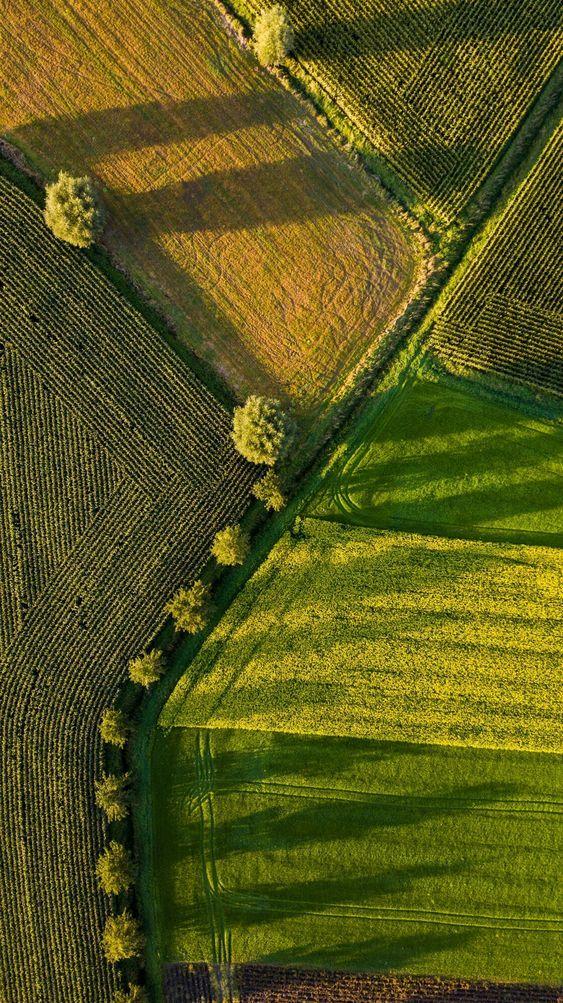

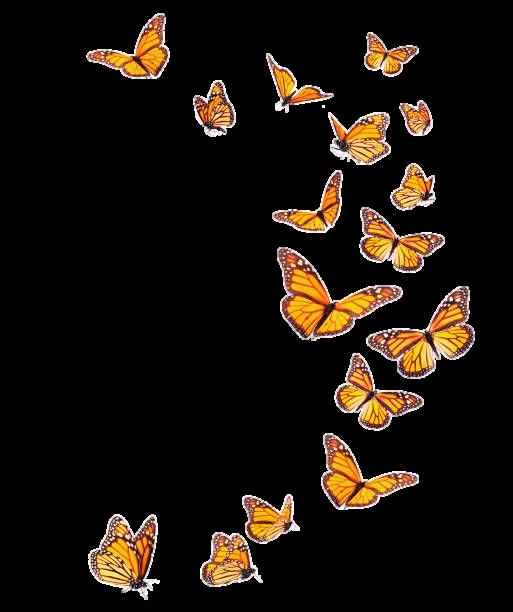



The Israeli military’s widespread aerial bombardment and ground invasion of the Gaza Strip for the past six months, killing over 34,000 people1 (not accounting for those missing under the rubble), has resulted in an ecological catastrophe that will scar the Strip and its people, already marred by an almost 17-year blockade, for decades to come. Often, the devastating impacts of war, or in this case, violence that could plausibly amount to genocide (according to the International Court of Justice)2, on the environment is rarely discussed but is a vital conversation to be had
Since the start of the war, the Israeli army has destroyed and damaged many waste management facilities in Gaza, with the UN Environment Assembly estimating at least 100,000 cubic meters of sewage and wastewater being dumped daily onto land or into the Mediterranean Sea This will likely exacerbate an already high level of chlorophyll and suspended organic matter in Gaza’s coastal waters caused by a history of marine pollution incidents.3 Due to the lack of municipality vehicles and sanitation workers, garbage lines the streets in Rafah In a video filmed by Palestinian journalist Bisan Owda, we see an overflowing container in front of a maternity hospital, spilling bloody bandages into an already trash-filled street. This leads to hazardous substances from solid
waste leaching into the soil and the sewage water, further polluting the streets. The 1.5 million refugees living there have limited access to clean water and sewage services due to 70% of Gaza’s infrastructure being destroyed As of February 11th, 2024, it was estimated that there were 45,000 metric tons of unmanaged solid waste in Gaza. Much of this unmanaged is burned, releasing hazardous gasses and particulate matter into the air.3
Not only is Gaza’s water supply being contaminated by unbridled waste pollution, but it is also being poisoned by the Israeli military’s use of white phosphorus weapons.4 White phosphorus exposure is highly dangerous; when in contact with human flesh, it can burn down to the bone, as well as set fields and structures on fire When these chemicals reach rivers and aquifers, they can be incredibly toxic to humans who rely on these sources of water,5 especially considering Gaza’s water scarcity as Israel continues to severely limit humanitarian aid, falling 15 liters short of the survival levels required by humanitarian standards 6 The contaminated waterways will affect Gaza’s ecosystem, fisheries, and the livelihoods of fishers; even before this genocide, Gazan fishers could only access six to fifteen nautical miles offshore due to the almost 17-year blockade.5 As of right now, 70% of Gaza’s fishing fleet has already been destroyed by the Israeli army White phosphorus also results in a
buildup of phosphoric acid in the soil, which depletes soil fertility and increases erosion, as well as contaminates the local crops and livestock on agricultural land,5 leaving Palestinians in Gaza with even fewer options for food. To add extra strain, 22% of farms in Northern Gaza have already been destroyed.6
In addition to the water, soil, and land pollution from chemical weapons and thousands of metric tons of solid waste, on January 7th there were an estimated 22.9 million metric tons of unexploded weapons, rubble, and debris from destroyed buildings,3 a number that has certainly since increased. There are also tens of thousands of bodies decomposing under the rubble,6 which pose a significant health risk due to disease, already spreading rapidly among the population. Building debris also contains pollutants like asbestos, heavy metals, fire contaminants, and hazardous chemicals (3) that could severely impact the health of millions of Gazans who have no safe place to go and are surrounded by destruction
Furthermore, Israel’s assault on Gaza has released copious amounts of carbon emissions into the atmosphere. During the first week alone, 29,000 bombs, the majority 2,000-pound bombs,6 were dropped on Gaza During just the first two months of the war in Gaza, 281,000 metric tons of carbon dioxide emissions were released, which is greater than the annual carbon emissions of 20 of the world’s climate-vulnerable nations. The Israeli State’s aerial bombardment and ground invasion of Gaza is responsible for 99% of carbon emissions released during the first two months of the war; this number is most certainly higher (previous studies suggest the true carbon footprint could be five to eight times higher) and doesn’t account for the emissions released after the first 60 days of the Israeli State’s assault,7 most notably as this genocide is entering its seventh month. These emissions come from aircraft missions, tanks, fuel from vehicles, and making and exploding bombs, artillery, and rockets.
Almost half of the CO2 emissions were caused by United States cargo planes flying military supplies to Israel. In addition, it is estimated that to rebuild Gaza’s destroyed infrastructure, the construction of over 100,000 buildings would require the release of at least 30 million metric tons of greenhouse gasses, which is higher than the annual emissions of 135 countries and territories,7 or around 0 5% of 2022 US emissions
In February 2022, the Intergovernmental Panel on Climate Change (IPCC) announced that the temperatures in the Mediterranean are rising 20% faster than the global average, already 1 5 degrees Celsius higher than preindustrial levels, compared to 1.1-1.3 degrees globally.8 As a result, even before this war, Gaza was already highly vulnerable to climate change, with these increasing temperatures as well as more frequent cold snaps (a brief period of very cold weather) during the winter Additionally, according to the International Committee of the Red Cross’s new report, Gaza is projected to see decreased rainfall by 20% by 2050.6 These climate risks will endanger over one million unhoused Gazans currently living in tents, destroyed shelters, or in the streets who are already threatened with bombardment, execution, starvation, disease, and insurmountable loss Omar Shoshan, the President of the Jordan Environment Union, put it simply: “Wars have a direct impact on climate change by increasing carbon emissions and destroying infrastructure. The Gaza Strip is a stark example in the face of a complex crisis from a humanitarian, environmental, health, and climate perspective due to the repeated wars it has experienced in recent years.”6
It’s important to know that environmental abuse in occupied Palestine did not start with the military invasion. In Gaza, it is estimated that around 90-95% of the water supply was contaminated and unfit for human consumption before this genocide started. In Gaza and the illegally occupied West Bank, Israeli military authorities have complete power over all water resources and water-related infrastructure; in November of 1967, they issued Military Order 158, preventing Palestinians from constructing any new water installation without a permit from the Israeli military, which is almost impossible to obtain Palestinians in the West Bank are not able to access the Jordan River and freshwater springs, and Israel controls the collection of rainwater throughout most of the West Bank and Gaza. About 180 Palestinian communities in rural areas of the West Bank have no running water, and if they do, taps often run dry Due to so many restrictions, Palestinians in the West Bank often have to pay for water brought in from trucks, and may even pay half a family’s income for water.9 Meanwhile, Israel develops its own water infrastructure for its settlers in the West Bank, who are there illegally under international law 10 The water inequity is so great that Israeli settler (9) communities in the West Bank, such as Ma’ale Adumim, have swimming pools
“Since 2000, it has destroyed over 3,000,000 trees through uprooting, poisoning, burning, or bombing, due to their cultural significance and indigeneity to Palestine.”
accessing a water supply four times greater than provided to Palestinian communities. In some West Bank communities, the water consumption can be as low as 20 liters per day, while the average Israeli water consumption is 300 liters of water per day 9
The Israeli State also disrupts Palestinian food sovereignty and agriculture. Since 2000, it has destroyed over 3,000,000 trees through uprooting, poisoning, burning, or bombing,11 due to their cultural significance and indigeneity to Palestine Often, certain organizations plant non-native trees in their place (this will be discussed further in the paper).12 The military also often bulldozes and displaces Palestinians from their homes and agricultural land to make room for more illegal settlers or military activity. In addition, many barriers have been placed to separate the State of Israel and Palestinian land, such as the apartheid wall in the West Bank and the walls that keep Gaza in an open-air prison. Many Palestinians have thus lost land on the Israeli side of borders, and are forced to try to obtain a permit to farm their own land, which is incredibly difficult to get This prevents Palestinians from being able to plant the food they need, and thus Palestinian markets are forced to rely on imports and exports from Israel. The barrier surrounding Gaza known as the buffer zone takes away 29% of Gazan farming land. Before the establishment of the Israeli State, farming was an integral part of the Palestinian economy, particularly in selling plums, olives and olive oil, oranges, grapes, and dates, producing more than current-day Israel.13 Gaza was a historically agrarian-dependent society, but the blockade has prevented the export of agricultural products such as fertilizer, farming, and irrigation equipment,6 leading to food insecurity Israel’s enforcement of the buffer zone through military encroachments leads to further environmental damage. The building of the iron wall itself, separating Gaza from the Israeli State, contributed to almost 274,000 metric tons of CO2, on par with almost all the 2022 emissions by the Central African Republic, one of the most climate-vulnerable countries in the world.7
Often, Israeli media, governmental officials, and military try to cover up their crimes and justify their claim to the land through forms of greenwashing This is done by portraying Israel as environmentally progressive and land conscious while simultaneously denying Palestinian indigeneity and portraying them as “backward” or “primitive,” and therefore less deserving of that land, reinforcing Israel’s claim to it This is juxtaposed by Israel’s severely detrimental effects on the environment, as well as organizations and settlers that repurpose the land in a way it was not meant for. For example in November 2023, at COP28 in Dubai, Gideon Behar, a special convoy for climate change and sustainability, claimed that Israel’s “biggest contribution to the climate crisis comes in the forms of “solutions” due to the presence of a climate technology industry with carbon capture and storage, water harvesting infrastructure, and the implementation of more plant-based meat.7 However, Israel has released several tons of carbon emissions through military activity, much more than Palestine; in 2019, seven million metric tons of carbon dioxide was released from the military alone, which was 55% more emissions than the whole of Mandatory Palestine.7
Another example of greenwashing is a nonprofit called the Jewish National Fund, which controls around 11% of Palestinian land.5 It has uprooted thousands of Palestinian olive trees, an integral part of the ecosystem, and has planted more than 250 million imported, non-native trees in their place to “make the desert bloom.” This prevents villagers from returning to their homes, “while also hiding the evidence that those homes ever existed,” according to the Washington Report on Middle East Affairs 12 Furthermore, illegal settlers in the occupied West Bank often uproot Palestinian olive trees in olive groves and agricultural plots, sometimes during harvest season.14 In Hebron, certain areas in Palestine are polluted with garbage that Israeli settlers constantly throw down at them from their settlements.15 These behaviors are only an aspect of the increasingly brutal settler violence that Palestinians in the West Bank face.
Olives hold deep cultural significance not only to the people of Palestine but in the wider Levant, including Lebanon and Syria. To the Palestinians, they are a symbol of peace, rootedness, and connectedness to the land. The uprooting of these native olive trees is a violent colonial tactic that not only destroys the native ecosystem but also attempts to deny any existence of Palestinian culture and indigeneity to this land. Indigenous peoples know their native plants and cherish them; colonists often do not. In an attempt to establish their claim to Palestinian land in the West Bank and deny Palestinian culture, illegal settlers and Israeli soldiers uproot the plants native to the land itself.
“After the partition plan and the Nakba, Palestinians lost much of their agricultural land to the Israeli State, the value of which is estimated to be $5 billion by today’s standards.”
Before the establishment of the State of Israel, Palestinians had a flourishing economy based on agriculture, producing wheat, barley, olives, citrus fruits 12 (Yaffa is known for their oranges), and more, which comprised up to 40% of their agricultural exports in the early 20th century. They grew vegetables, including potatoes, and often used systems of subsistence farming. After the partition plan and the Nakba, Palestinians lost much of their agricultural land to the Israeli State, the value of which is estimated to be $5 billion by today’s standards 16
Zionism is a form of colonialism that disrupts Palestinian indigenous practices and violently uproots people from their land in the name of supposed safety To understand social and environmental justice movements, we must come from an understanding of what colonialism is, how it has impacted indigenous communities, and how it has resulted in a loss of indigenous practices that care for the land; Palestine is no exception. To understand colonialism is to understand the exploitation of land and the devastating impacts it holds over the environment and the native peoples and people of color who are disproportionately affected by environmental abuses We cannot call for the safety of all people as long as this colonial system that has resulted in apartheid, genocide, and ethnic cleansing continues to ravage the Palestinian people. No one can ever truly be safe in the Holy Land as long as these systems are still in place. If we want safety, justice, and freedom for all peoples, regardless of ethnicity, nationality, religion, or skin color, we must dismantle these systems of oppression that devalue and dehumanize Palestinian life. Global justice and freedom for all can be secured when we recognize that we must all be free We must understand that a ceasefire is not enough; we need justice, clarity, and a right of return for the Palestinian people There is no more “progressive” without Palestine None of us are free from oppression until the Palestinians are.
9. References
1.
Usaid Siddiqui, “In Numbers: 200 Days of Israel’s War on Gaza,” Al Jazeera, April 23, 2024, https://www .aljaz eera.com/news/2024/4/23/by-the-numbers-200-days-of-israels-war-on-gaza.
2.
OHCHR, “Gaza: ICJ Ruling Offers Hope for Protection of Civilians Enduring Apocalyptic Conditions, Say UN Experts,” n.d., https://www.ohchr.org/en/press-releases/2024/01/gaza-icj-ruling-offers-hopeprotection-civilians-enduring-apocalyptic#:~:text=The%20ICJ%20found%20it%20pla usible,under%20sie ge%20in%20Gaza%2C%20and.
3 “Israel: White Phosphorus Used in Gaza, Lebanon,” Human Rights Watch, October 13, 2023, https://www.hrw.org/news/2023/10/12/israel-white-phosphorus-used-gaza-lebanon.
Lottie Limb, “The UN Is Investigating the Environmental Impact of the War in Gaza. Here’s What It Says so Far,” Euronews, March 6, 2024, https://www.euronews.com/green/2024/03/06/the-un-isinvestigating-the-environmental-impact-of-the-war-in-gaza-heres-what-it-says-so-
4. Isaiah, “War Has Poisoned Gaza’s Land and Water. Peace Will Require Environmental Justice.,” The Century Foundation, December 19, 2023, https://tcf.org/content/commentary/war-has-poisonedgazas-land-and-water-peace -will-require-environmental-justice/
5. Amali Tower, “The Not-So-Hidden Climate Risks for Gaza’s Displaced Climate Refugees,” Climate Refugees, February 19, 2024, https://www climaterefugees org/spotlight/2023/1/11/gaza#:~: text=In%20addition%20to%20the%20humanitarian,anywhere%20else%20in%20the%20world.
6. Nina Lakhani, “Emissions From Israel’s War in Gaza Have ‘Immense’ Effect on Climate Catastrophe,” The Guardian, January 10, 2024, https://www.theguardian.com/world/2024/jan/09/emissions-gazaisrael-hamas-war-climatechange#:~:text=3%20months%20old-,Emissions%20from%20Israel's%20war%20in%20Gaza,immen se'%20effect%20on%20climate%20catastrophe&text=The%20planet%2Dwarming%20emissions%2 0generated,vulnerable%20nations%2C%20new%20research%20reveals
7. Glenn Scherer, “Cradle of Transformation: The Mediterranean and Climate Change,” Mongabay Environmental News, April 28, 2022, https://news.mongabay.com/2022/04/cradle-of-transformationthe-mediterranean-and-climate-change/.
8. Amnesty International, “The Occupation of Water,” August 5, 2022, https://www.amnesty org/en/latest/campaigns/2017/11/the-occupation-of-water/
10. Amnesty International, “Chapter 3: Israeli Settlements and International Law,” July 29, 2021, https://www.amnesty.org/en/latest/campaigns/2019/01/chapter-3-israeli-settlements-and-internationallaw/#:~:text=Most%20states%20and%20international%20bodies,are%20illegal%20under%20internati onal%20law.
11 Conflict and Environment Observatory, “Tree Planting as Resistance in Palestine,” CEOBS, September 8, 2021, https://ceobs.org/tree-planting-as-resistance-in-palestine/.
12. WRMEA, “Film Uncovers Truth About JNF’s Tree Planting in Israel,” August 18, 2023, https://www.wrmea.org/israel-palestine/film-uncovers-truth-about-jnfs-tree-planting-in-israel.html.
13. “Food Insecurity in Palestine: A Future for Farmers,” Wilson Center, n.d., https://www.wilsoncenter.org /article/food-insecurity-palestine-future-farmers.
14. Doha Asous, “‘They Ransack Our Village for Sport’: One Palestinian Farmer’s Story of Israeli Settler Violence,” The Guardian, March 10, 2023, https://www.theguardian.com/world/2023/mar/05/palestinian-farmer-israeli-settlers-west-bank-wipedout-olive
15. AJ+, “How Israeli Apartheid Destroyed My Hometown,” October 27, 2022, https://www.youtube.com/watch?v=aEdGcej-6D0.
16. Wikipedia contributors, “History of Agriculture in Palestine,” Wikipedia, April 22, 2024, https://en.wikip edia.org/wiki/History of_agriculture_in_Palestine.
Tijuana’s aging sewage infrastructure has resulted in significant coastal water pollution, leading to prolonged beach closures and heightened health risks across the California-Mexico border. Recreational exposure to polluted water contributes to approximately 90 million cases of water-related illness annually in the US (DeFlorio-Barker, Wing, et al , 2018) While the South Bay International Wastewater Treatment Plant (SBIWTP)
Expansion Project aims to double sewage treatment capacity in the US, the current proposal focuses primarily on physical infrastructure improvements, lacking funds for community outreach and research. This brief advocates for a more comprehensive approach that integrates physical infrastructure improvements with community involvement to reduce human exposure to pollutants in the ocean and health risks.


Over the past four decades, Tijuana, Mexico, has seen substantial population and industrial growth, leading to rapid urbanization This expansion has strained the aging sewage infrastructure in the region over time, causing recurring sewage issues. Sewage problems involve Mexicangenerated sewage flowing into California impacting water quality and posing health risks to people on both sides of the border.
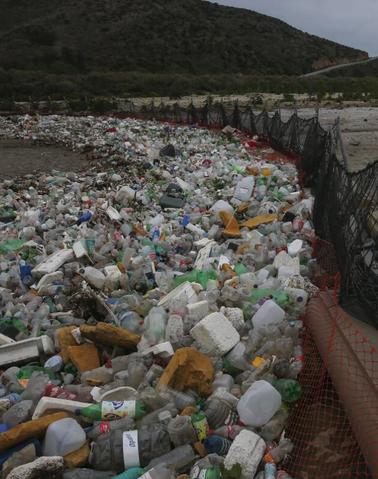
The San Diego South Bay and Tijuana region has significant water quality issues due to inflows of untreated sewage from two sources: the Tijuana River Estuary (TJRE) and the San Antonio de los Buenos outfall at Pt. Bandera (SAB/PTB) (Fedderson, et al , 2021)
Over the past five years alone, 100 billion gallons of toxic waste have flowed into US coastal waters from Tijuana (Murga, 2023). The contaminated water has resulted in the closure of local beaches for over 700 consecutive days (Rios, 2023)
In a recent interview, Imperial Beach Mayor Paloma Aguirre explained, “This is affecting over 750,000 people. Threequarters of a million Californians are breathing in raw sewage” , referring to the underserved residents of the cities of Imperial Beach, Chula Vista, National City, and the southern neighborhoods of San Diego (Rios, 2023)
In the US, approximately 90 million cases of water-related illnesses (gastrointestinal, ear, eye, respiratory, skin issues, etc.) are reported each year due to recreational exposure to polluted water (DeFlorio-Barker, Wing, et al., 2018). Engaging in recreational activities involving polluted ocean waters is linked to increased health risks in Southern California (Haile, et al., 1999). However, knowledge gaps become apparent when considering the specific health implications of the water pollution crisis in the Tijuana-San Diego region.
Using wastewater data from 2017, one study’s model estimated the concentration of norovirus at Imperial Beach. In the baseline scenario scenario, about 3.8% (offseason) to 4.5% (tourist season) of people who swim in the water develop swimmer’s illness and can experience diarrhea, vomiting, skin rashes, ear aches, etc. (Fedderson, et al., 2021). Another study found that coastal water pollution in Imperial Beach transfers to the atmosphere via sea spray aerosol, potentially exposing many people along coastal land to dangerous bacteria and chemical compounds (Pendergraft, et al., 2023). The study’s authors emphasized that the public health impacts of aerosolized coastal water pollution must be investigated further to determine the level of risk. There is also a need for a more comprehensive understanding of the prevalence and impact of waterborne illnesses from coastal water pollution.
Image of debris near TJRE from Los Angeles Times
South Bay International Wastewater Treatment Plant (SBIWTP) Expansion Project: The SBIWTP processes an average daily volume of 25 million gallons of untreated sewage and wastewater This includes sewage surpassing Tijuana's treatment capacity and cross-border waters gathered from five canyon collectors in the San Diego region (Lim, 2018).
In 2021, the Environmental Protection Agency (EPA) allocated $300 million to cover the expansion of the treatment plant, which would double the amount of sewage it treats to 50 million gallons per day
The US section of the International Boundary Water Committee will carry out the project. In October 2023, President Biden’s proposed supplemental funding request to Congress allocated an additional $310 million in emergency spending to “prevent and reduce sewage flows and contamination in Southern California through support for ongoing design and construction at the [SBIWTP] ” However, the request does not give supplemental funding to other wastewater treatment projects that would have a greater net benefit to local communities and does not allocate funding for community outreach and research.
In 2004, the federal government was sued by the Border Patrol union for exposure to “raw human sewage, massive coliform contamination, and other toxic chemicals” in the Tijuana River area (John Abbott, et al. v. U.S.).
The union won a $15 million payout A Border Patrol agent is believed to have contracted group A strep, a flesheating bacterial infection, from training in contaminated waters near Imperial Beach in 2010 (Kelly, 2018)
As far back as 1973, the US federal government has been acutely aware of the coastal water pollution crisis in the region and has failed to implement a longterm solution (Navarro, 2023).
Members of the IBWC and San Diego residents should call upon the executive branch to issue an emergency declaration about the coastal water pollution crisis. This would allow the IBWC to access essential funds with more ease in the future and ensure the success of the SBIWTP expansion.
1. The current proposal primarily focuses on physical infrastructure improvements to address sewage pollution without allocating funds for community awareness and involvement Federal funding should be allocated to the affected BIPOC communities in the South Bay of San Diego to inform residents about health precautions and necessary actions to minimize pollution exposure.
To address our current knowledge gaps, federal funding should be allocated for public health research on the effects of coastal water pollution in the Tijuana-San Diego region. Risk characterization assessment should be prioritized 3.
US federal funding should also go to improving the wastewater treatment plant in San Antonio de Los Buenos, Mexico. Multiple studies have found that reducing the sewage inflows from SAB would have a greater impact on water quality than just addressing sewage issues from the TJRE (the US IBWC’s current priority). Reducing SAB inflows would immediately reduce the risk of swimmer’s illness and the number of beach closures (Fedderson et. al, 2020; Fedderson et. al, 2021). 4
The San Diego I know and love is made up of BIPOC and immigrant communities that haven’t had access to the coast for years because of an environmental crisis the State is complicit in ignoring. As we confront this injustice, we must amplify the voices of those most affected and advocate for a future where our children can play in the sands and waters of the beaches we grew up loving.

DeFlorio-Barker, Stephanie, et al “Estimate of incidence and cost of recreational waterborne illness on united states surface waters.” Environmental Health, vol. 17, no. 1, 2018, https://doi.org/10.1186/s12940-017-0347-9.
Feddersen, Falk, et al. “Modeling untreated wastewater evolution and swimmer illness for four wastewater infrastructure scenarios in the San Diego‐Tijuana (US/MX) border region ” GeoHealth, vol 5, no 11, 2021, https://doi org/10 1029/2021gh000490
Fedderson, Falk, et al. “Modeling Impacts of Various Wastewater and Stormwater Flow Scenarios on San Diego South Bay and Tijuana Beaches.” NADB, North American Bank Development, 2020, www.nadb.org/knowledge-resources/studies-publications/modeling-impacts-of-variouswastewater-and-stormwater-flow-scenarios-on-san-diego-south-bay-and-tijuana-beaches
Haile, Robert W.; Witte, John S.; Gold, Mark; Cressey, Ron; McGee, Charles; Millikan, Robert C.; Glasser, Alice; Harawa, Nina; Ervin, Carolyn; Harmon, Patricia; Harper, Janice; Dermand, John; Alamillo, James; Barrett, Kevin; Nides, Mitchell; Wang, Guang-yu. The Health Effects of Swimming in Ocean Water Contaminated by Storm Drain Runoff. Epidemiology 10(4):p 355-363, July 1999.
Kelly, Chris “Flesh Eating Bacterial Infection Extinguishes the Dreams of a Former Border Patrol Agent ” Coronado Times, 10 Mar. 2018, coronadotimes.com/news/2018/03/10/flesh-eating-bacterialinfections-extinguishes-dreams-former-border-patrol-agent/.
Lim, Joann. “San Diego Region - International Wastewater Treatment Plant.” International Wastewater Treatment Plant | San Diego Regional Water Quality Control Board, 2018, www waterboards ca gov/sandiego/water_issues/programs/iwtp/
Murga, Tammy. “Biden Requesting $310m to Fix, Expand Wastewater Treatment Plant Fouling San Diego’s South County.” Tribune, San Diego Union-Tribune, 26 Oct. 2023, www.sandiegouniontribune.com/communities/south-county/story/2023-10-25/biden-wastewatertreatment-san-diego
Rios, Pedro. “San Diegans Hold Their Breath as Newsom Defers to Washington D.C. on Tijuana River Sewage Crisis.” CalMatters, 20 Nov. 2023, calmatters.org/commentary/2023/11/san-diego-tijuanariver-sewage/. For PBHLTH 150B Human Health and the Environment in a Changing World, Prof. Ajay Pillarisetti, Fall 2023
The forces of industrial agriculture spread throughout the fields and farmlands of Earth in search of the cheapest labor to sustain itself with, creating an imbalance between the labor power of the global South and consumer lifestyles in the global North. Fruits of Labor illustrates such an imbalance as it exists between Mexico and the U S , documenting the life of a Mexican-American teenager in an agricultural town in central California. The narrative of Ashley Solis details the burdens she faces as the eldest daughter of a single-mother immigrant household, working two jobs in the strawberry fields and at a food packaging company while finishing her senior year of high school In this paper, I will engage with Marxist theory and the Feminist Political Ecology (FPE) framework to explore how Ashley’s narrative reveals the complex intersecting power relations imposed by the neoliberal industrial food regime First, I will focus on the Marxist concept of commodity fetishism to analyze the subordination of Mexican farmworkers within industrial agriculture systems. Then, I will draw upon feminist perspectives on Marxism to examine the gendered social-relations of the female wagedlaborer Finally, using the FPE framework, I will interrogate laboring bodies as a commodity through the everyday experience of the Mexican female farmworker.
ByI. Commodity fetishism conceals the subordination of Mexican farmworkers within industrial agriculture
In Capital, Vol. 1, Marx criticizes the world of commodities, writing that it “conceals the social character of private labor and the social relations between the individual producer” (Marx 1867, 236). His conception of commodity fetishism identifies a phenomena by which the labor and social relations that produce commodities become abstracted and hidden In Fruits of Labor, shots of workers in the fields, gloved hands sorting strawberries on a conveyor belt, and news reportings of ICE raids reveal the production processes that are abstracted by the neoliberal industrial food regime, and the labor used to sustain it—that is, the labor of Mexican-American and Mexican immigrant farmworkers. Similarly, Deborah Barndt focuses on the narratives of six Mexican migrant laborers within tomato production in her essay “Fruits of Injustice,” criticizing the dynamics within Mexico whereby southern i



impoverished regions feed cheap migrant labor to the richer industrial North” (Barndt 2002, 83) Marx recognized that the private labor and social relations of individual producers are concealed by commodity fetishism; the film and Barndt complicate this idea by documenting how labor in the neoliberal industrial food regime is racialized because it subordinates the Mexican farmworker, which is further reinforced by the power dynamics of immigration between the U.S. and Mexico. Thus, that consumers concern themselves with the sweetness of strawberries and ripeness of a tomato exemplifies how commodity fetishism actively erases the complexities of immigration and the subordination of Mexican farmworkers, which provides the labor necessary to uphold industrial agriculture and bring these fruits to the dinner table.
II. Feminist Marxism reveals the gendered social relations of the Mexican female waged-laborer
Feminist perspectives on Marxist theory expand on analyses of capitalist development by focusing on the reproductive labor of women. A key understanding of Feminist Marxism is that the social subjugation of women is fundamental to the accumulation of capital; female labor signifies a unique form of exploitation in capitalist modes of production, which remains the case in the context of the neoliberal industrial food regime. Silvia Federici wrote in Caliban and the Witch that “the discrimination that women have suffered in the waged work-force has been directly rooted in their function as unpaid laborers in the home” (Federici 2004, 94). The film consistently features Ashley’s familial duties as the eldest daughter of an immigrant household: she brushes her younger sister’s hair before school, pays for meals, and even sees herself financially responsible for her younger brother’s
unborn child. Ashley’s burdens are further complicated by immigration, as she is seen throughout the film to be translating papers and meetings for her undocumented mother. Through the six stories of Mexican female farmworkers featured in her essay, Deborah Barndt argues that “women are key protagonists for their families, in their triple functions: as salaried workers, as subsistence farmers, and as domestic laborers” (Barndt 2002, 87). In all cases, the Mexican female waged-laborer is exploited not only for farm work within industrial agriculture, but she also is dually responsible for domestic labor at home. Building on the notion of commodity fetishism, Feminist Marxism recognizes that the social relations abstracted by the commodity operate on gendered dimensions. These gendered social relations, embodied by the unpaid reproductive forces of Mexican female farmworkers, are therefore necessary to capital accumulation—in the form of increased production of strawberries and tomatoes for sustaining the neoliberal industrial food regime.
“A key understanding of Feminist Marxism is that the social subjugation of women
is
fundamental to the accumulation of capital; female labor signifies a unique form of exploitation in capitalist modes of production, which remains the case in the context of the neoliberal industrial food regime.”
IThe Feminist Political Ecology (FPE) framework recognizes the body as “a scale and location upon and through which ideas, ideologies and politics unfold and are made visible” (Mollett et. al 2020, 275). Ashley’s life, as documented by Fruits of Labor, is representative of this core FPE belief because it portrays her as a laboring body: working two jobs, providing financially for her immigrant household, and pursuing education Her narrative actively highlights the politics of immigration, racialized labor of Mexican farmworkers within industrial agriculture, and gendered social relations of female waged-laborers. Therefore, FPE framework positions the everydayness of the Mexican female farmworker to demonstrate that beyond the strawberry and the tomato, commodity fetishism within the context of industrial agriculture works to conceal the commodification of laboring bodies themselves Ashley’s life becomes increasingly about earning wages and supporting her family, rather than the teenage experience of graduating highschool and going to the prom Barndt asserts that “it is a feminist act to make visible the women workers in the food system” (Barndt 2002, 84). Using the FPE framework to center a laboring body, as Fruits of Labor does with Ashley, makes visible the reality that the neoliberal industrial food regime commodifies the labor of marginalized Mexican farmworkers and is sustained specifically by the unpaid reproductive powers of the Mexican female waged-laborer.
Marxist theory, Feminist Marxism, and Feminist Political Ecology provide powerful frameworks by which to deconstruct labor within industrial agriculture. Doing so through the narratives of Mexican female farmworkers, as is done in Fruits of Labor, reveals the complex intersecting power relations imposed by the neoliberal industrial food regime. Ashley’s story implicates discussions of labor as it pertains to power dynamics between the U.S. and Mexico in addition to the gendered social relations of farmworkers. An analysis using the Marxist idea of commodity fetishism examines how the commodification of food products such as the strawberry and the tomato conceals racialized labor in industrial agriculture through the subordination of Mexican farmworkers and the complexities of immigration. Engaging with Feminist Marxism reveals the labor and social relations of farmworkers concealed by commodity fetishism operate within gendered dimensions, recognizing how the neoliberal industrial food regime relies on the unpaid domestic labor of Mexican female farmworkers to sustain itself. Finally, FPE emphasizes the body as a site of visibility, highlighting the laboring bodies of Mexican female farmworkers as they are being commodified by the production processes of globalized industrial agriculture
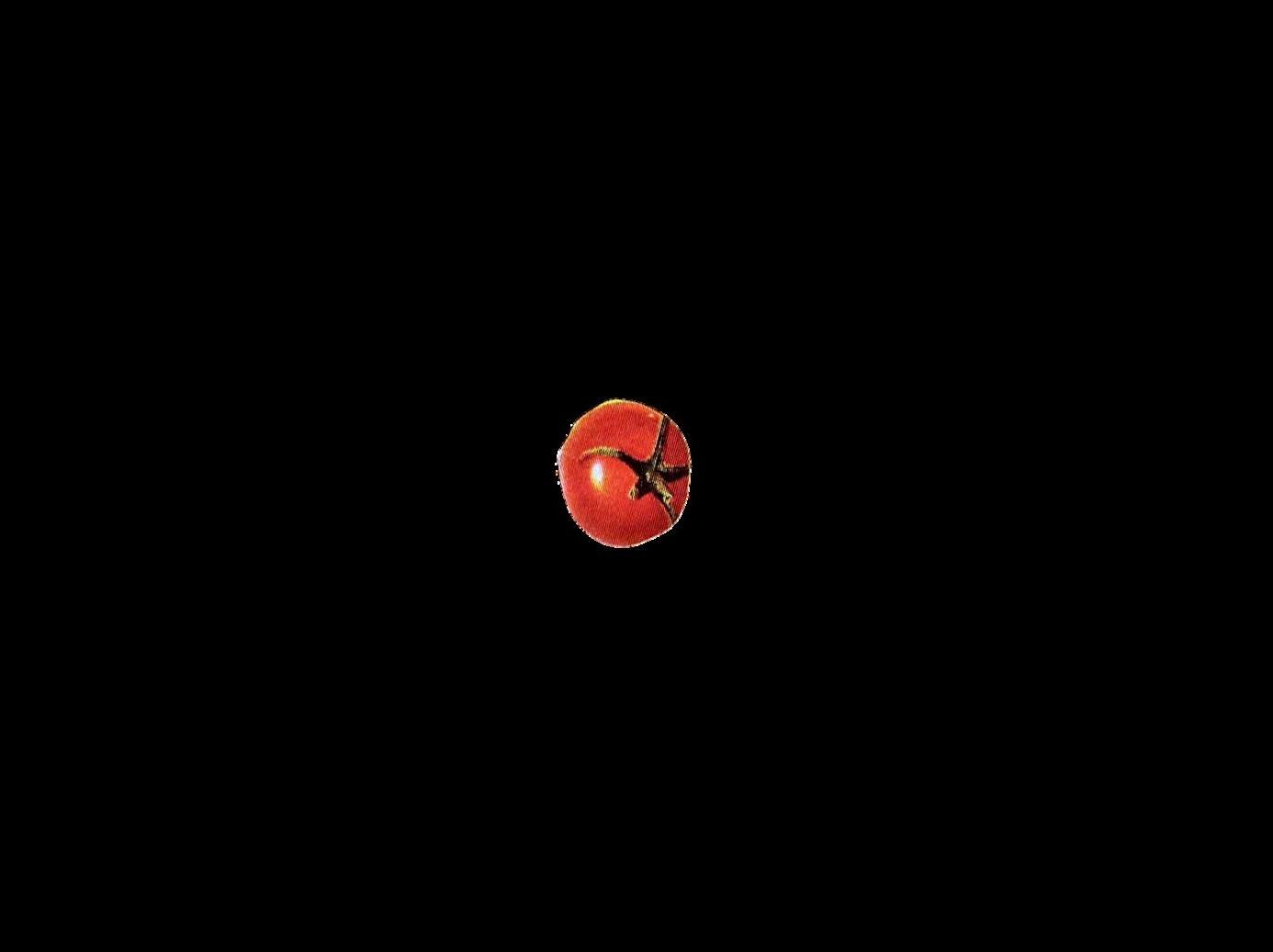










Barndt, Deborah. “Fruits of Injustice: Women in the Post-NAFTA Food System.” Mexico in transition, 2013, 82-8 https://doi org/10 5040/9781350221376 ch003
Federici, Silvia. Caliban and the Witch. New York, NY: Autonomedia, 2004.

Marx, Karl. Capital, Vol. 1, (1867) in Selected writings, edited by Lawrence H. Simon., 214-300. Indianapolis/Cambridge: Hackett, 1994.
Mollett, Sharlene, Laura Vaz-Jones, and Lydia Delicado-Moratalla. “Feminist Political Ecologies ” Routledge Handbook of Gender and Feminist Geographies, April 8, 2020, 271–284. https://doi.org/10.4324/9781315164748-27.




For ENERES C140, Gender and Environment, Prof. Youjin Chung, Spring 2023
 By Kavina Peters
By Kavina Peters
As a child of immigrants, I have had a complex experience with acculturation into American value systems A large part of this experience centers on the clash of values regarding consumption in everyday life. To this day, one of the longest ongoing arguments I have with my mother surrounds her anxiety that I have become or will become a 'wasteful American'. In this paper, I will examine the full extent of this anxiety, beginning with an exploration of my mother's values developed from her family history and childhood in south India, her immigration to the United States, and finally, the relationship with natural resources she has instilled in our household and myself.
My mother was born in the small town of Srirangam in Tamil Nadu, India, a river island situated between the Kaveri and Kollidam rivers. This geography shaped the life and culture of the region, as an area heavily dependent on agriculture and an enclave for religious worship between the two holy rivers. Srirangam holds one of the oldest and largest functioning Hindu temples in the world: the Sri Ranganathaswamy Temple, which thousands of pilgrims flock to every year. Thus, the culture my mother grew up in was largely influenced by the philosophies of Hinduism, which think of natural systems as mother goddesses and assign a need for collective protection of ecosystems through the Karmic Law of Nature
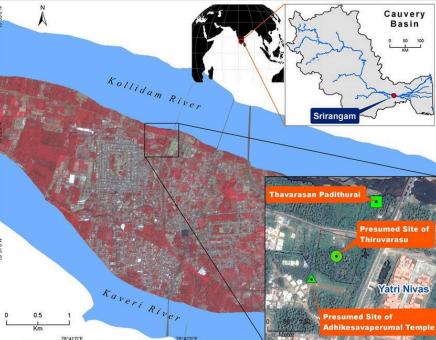
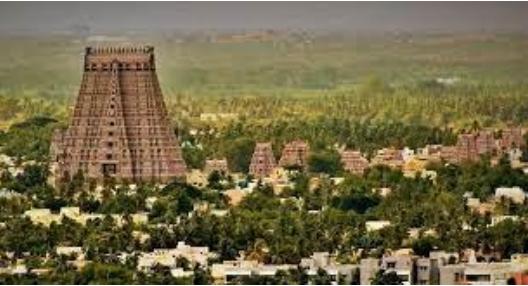 The Geography of Srirangam and historical religious sites (cite: Ramkumar)
The Geography of Srirangam and historical religious sites (cite: Ramkumar)
Just as geography and religion have shaped my mother's value of natural resources, so too has her family history Her father grew up on an Areca nut plantation high up in the hills of the neighboring state of Karnataka, while her maternal side is native to the Cauvery delta. My mother points out that the traditional land management of the two regions was drastically different: "My maternal side is from the semi-arid Cauvery delta famed for its irrigation prowess and my paternal side from the rainfed slopes of the western ghats". My mother's Tamil side of the family was heavily connected to these innovative irrigation systems, considering themselves to be of a historical lineage of 'Water Engineers' tasked with traditional methods of water protection and cultivation Even one of my mother's maternal uncles was an army engineer focused on dam building in the Cauvery Delta water system.
“Graywater was used to water the kitchen garden, water for washing and bathing was heated by burning garden waste, all food consumed was processed from grain, legumes, and produce directly from the kitchen garden or nearby farms, most household consumables were organic and biodegradable, and transportation was largely by foot, bicycle and public buses.”
In our conversation, my mother reminisces on the beauty of her hometown during her childhood in the 60s and 70s before the rapid industrialization of the 80s and 90s. She also describes the way in which her family conserved resources and lived circularly. Graywater was used to water the kitchen garden, water for washing and bathing was heated by burning garden waste, all food consumed was processed from grain, legumes, and produce directly from the kitchen garden or
nearby farms, most household consumables were organic and biodegradable, and transportation was largely by foot, bicycle and public buses. My mother believes this type of circular consumption informs her current idea of sustainability and morally responsible living.
When my mother immigrated to the United States for graduate school in 1985, this moral understanding of sustainable living, informed by her religion, familial background, and upbringing, put her directly at odds with American consumerism. She describes being appalled by the average American's wastefulness and lack of respect for material items She struggled, as many immigrants do, with the pressures to acculturate into an American lifestyle, and thought that this factor of consumption in American life went against everything she believed in. My mother was described as an 'Econut', for the practices and values that were seen as basic moral responsibility in her upbringing.
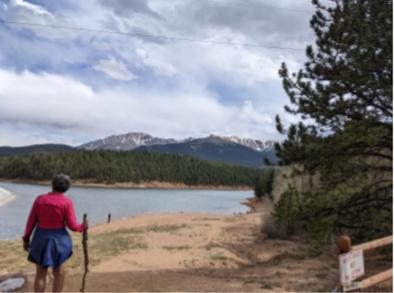

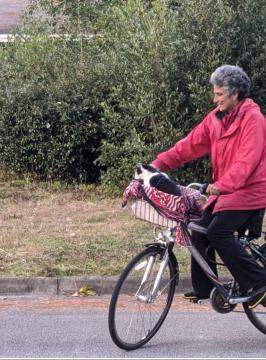
Today, after over thirty-five years of living in America, my mother continues to run our household with the lowest footprint possible: she doesn't heat or cool the house, utilizes an induction stove, bikes or walks everywhere, recycles and composts consistently, and rarely buys new consumer goods outside of groceries. While still in graduate school, my mother also found an appreciation for types of recreation in nature that were not available to her in India. She fell in love with windsurfing, canoeing, hiking, and camping, and plans trips with these activities for my family at least once a year. It is in this environment that I learned to value the world around me and develop my own version of a circular life.
I will admit, like many children of immigrants, I found our lifestyle unappealing and embarrassing growing up. I disliked bringing friends over because I had to explain what composting was or brave the heat when my mother refused to turn on the AC. However, I have come to understand her point of view over time. I can confidently say that I discovered my interest in environmentalism and aspects of food sovereignty through my mother's guidance I follow her example by walking and biking everywhere, having a cupboard full of plastic items that I reuse, and recycling regularly. I have fallen in love with waste-free fashion, opting to reuse old projects or repurpose unused clothing In my life, I want to believe that I hold respect for the material items I use every day, not only for the raw materials but also for the hard work and artistry that may have gone into creating them. There are ways in which I find it difficult to live as consciously as I would like, especially given the fact that waste is so ubiquitous in our lives now. But over time, I have developed my own values and practices of sustainable living that I adhere to as best as I can.
Taking all of my mother's background and values into account as well as all of my own, it is clear how heartbreaking it was to hear that she believes I could become a 'wasteful American'. She equates 'Americanness' to be rooted in casual, uncaring overconsumption, and it scares her that I could throw away all of the values she has taught me because of influence from the dominant society I was socialized in. In her mind, my total acculturation into American culture and consumer culture would be unconscionable and a destruction of my moral values
Therefore, becoming a 'wasteful American' is one of the worst insults my mother can give me In conversation with her about this paper, I brought this up and asked her if she truly believed I would become wasteful. She replied that she thinks she has instilled good values in me and a true respect for nature and resources, but that she could never really be sure. She remarked that she would take the blame, as it was her decision to raise me in the United States, in this consumer culture. I can only reflect that this is a common experience for the children of immigrants in America, coming to terms with the opposing values of two cultures, and attempting to treat the earth with respect


I can only reflect that this is a common experience for the children of immigrants in America, coming to terms with the opposing values of two cultures, and attempting to treat the earth with respect.
For ESPM 50AC Introduction to Culture and Natural Resource Management, Prof. Kurt Spreyer, Spring 2023
Becoming involved in the eco-community Working at the Berkeley Student Farms
Inspired by the No Movie concept of East LA artist collective ASCO, I created a still for a black and white short film titled From the Inside. The concept revolves around the privilege of staying at home, inside, amid sweltering heat while others (so often low-income Latinx immigrants) work in the California fields and food processing facilities Political and social meaning becomes assigned to the mundaneness of staying inside on a 100+ degree July afternoon in the San Joaquin Valley.
In the foreground is an ofrenda made from one of my mother’s dresses (a gift from my paternal grandmother), a Virgen candle lit by my sister, plums my father brought from his factory job, and a glass of ice water. It is an offering and token of remembrance to those who must labor in the heat and to our rapidly changing Mother Earth
For CHICANO 130: MeXicana Art History, Thought, and Practice, Prof. Jesus Barraza, Summer 2023
When I was a child, chaparral child, aliveness was magical
Centipede/ helicopter leaf/ slug/ toad/ walking stick/ stick bug/ ladybug/ red ant/ anthill/ cricket/ lizard/ rolly polly/ do not wander during recess/ a bobcat is prowling on the hill
Aliveness was spectacular worthy of a curtain call not because I spectacularized it but because it was new.
I’d only been sharing the world with frogs/ spiders/ thorns/ cacti/ sap/ trees that sting/ trees to climb/ stink bugs/ for seven years.
My mother says a child knows right from wrong at age seven in Filipino culture. I collected trash on dead hills in first grade during recess with a trash picker to earn tickets for a prize Confession
I ate an ant once.
We’d only been sharing the world for seven years
Oh, drowning school bell/ wind chime/ whisper/ thimble/ opal/ sun in my eyes
Sorry I heard you but did not listen I was chasing a cabbage butterfly origin: Silk Road. in California: by European transit. species: invasive. color: cream white with brown spots. family: pieridae. notes: use pesticide to remove from cabbage or cauliflower gardens
What does it mean to be an American seven-year-old?
It means when the bush by church gives you a rash you get your blood drawn and it is terrifying
Why is my blood in the chaparral and not the motherland–?
My blood is in the chaparral
My blood is in the chaparral
I’ve pricked my finger
Dear God
Please don’t let mom use a needle to remove the splinter/ skin of a coastal coral tree
origin: South Africa in California: thanks to a pioneering Italian horticulturist. name: erythrina caffra. pruned: seasonally. reason: cleanliness. known for: striking coral flowers. flowered: never.
Dream of the bees/ night sky petunias/ poinsettias/ hummingbirds/ koi fish/ cranes/ Mindanao bleeding-hearts/ Mindanao bleeding-hearts/ Mindanao bleeding-hearts/ Mindanao bleeding-hearts
Dream them back into existence now and at seven and at twenty and before the illegal logging and mining and after and remember, you may be in the chaparral, but your Blood is not. And your Heart is not
You will sew a web of silk and STRIKE at those imperialist motherfuckers.
//LIFE IS PRECIOUS//
For ASAMST 190: Poetry for Palestine, Prof. Dina Omar, Spring 2024
 - Arundhati Roy
- Arundhati Roy
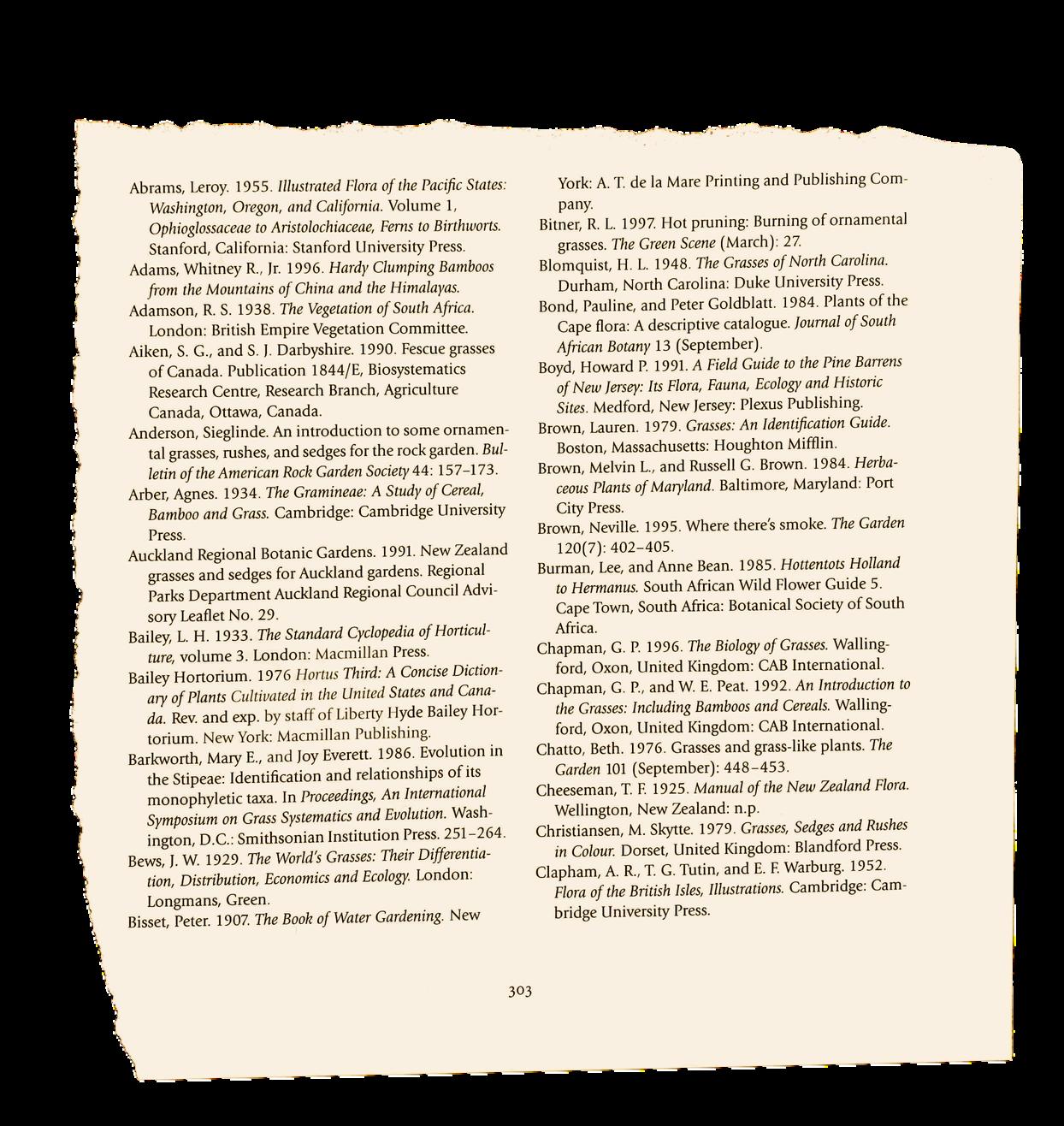





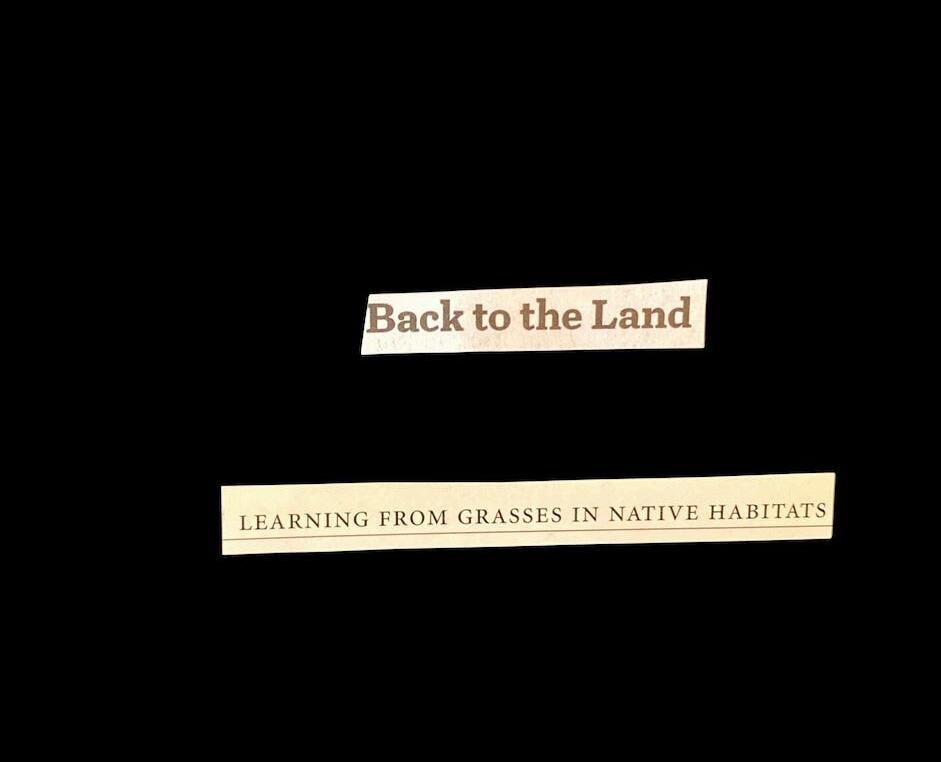
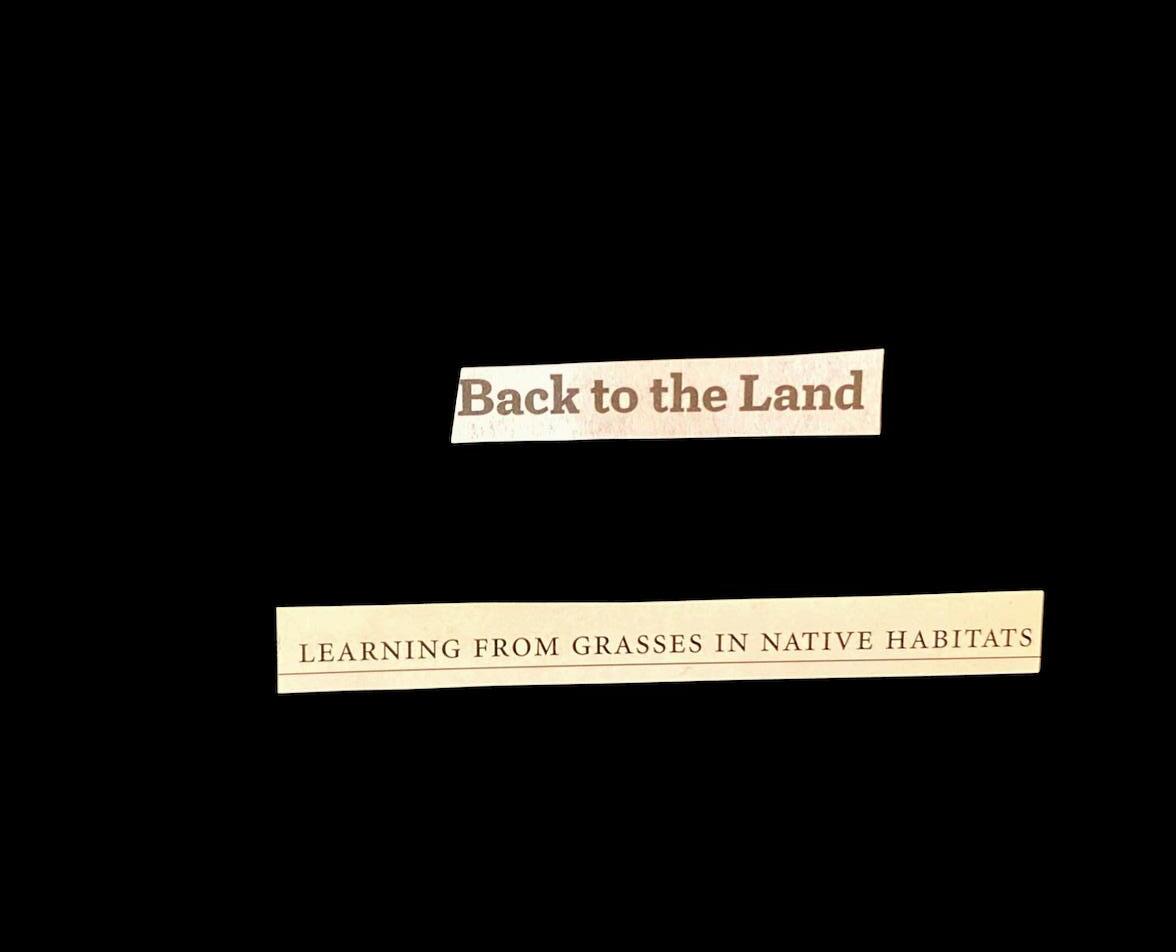


Eyes closed. Starts to sing.
Mother, mother
There's too many of you crying
Brother, brother, brother
There's far too many of you dying
You know we've got to find a way
To bring some lovin' here today, yeah
A few moments of silence...
How many of you recognize that song?
Unfortunately, I don’t sound like Marvin Gaye, but did you know that this song was written based on the infamous “Bloody Thursday” at Berkeley’s very own People’s Park in 1969?
While touring with Four Tops, Motown singer Renaldo "Obie" Benson witnessed firsthand the police brutality and deadly force occurring at the park. It inspired him to write this song and offer it to Marvin Gaye.
Sixty years later, and we are still trying to bring some lovin’ here today. Today, I want to bring love into this space.
I want to talk about my mother.
My mother is five foot two, yet she also holds seven different continents
She packed my lunch every day growing up, and she also grew every ingredient with her fertile soil, clean water, and plentiful sunlight.
She’s fifty-two years old, but also 4.5 billion years young.
I don’t thank my mother enough for what she does for me. Sometimes, when I try to, I feel as if my language was stolen from me.
Colonialism and imperialism have destroyed countless cultures and then covered up the crime with the erasure of language That way, we can’t even express what’s been lost It has disrupted our language, hopes, and emotions Rituals and ceremonies are suddenly foreign and looked down upon.
4
Why do I alienate people and things that I don’t understand?
Why do I need to have control over everything?
How does hate come out of my mouth so much easier than love?
These are the types of questions that I can go to my mother with.
At Standing Rock, peaceful Indigenous activists were attacked with tear gas, dogs, and weapons as they tried to conduct ceremonies and prayers for the water, land, and its inhabitants. These inhabitants included the police and security personnel who were actively harming them
One water protector stands with candy in her palm and says, “This is my weapon.” She walks to the blockade and offers it to a police officer, who is in full riot gear. She ends the interview by saying, “I just want them to feel.”
Can I show compassion to those targeting me?
Can my protest be joyful?
How can I be kin with someone who doesn’t see me as an equal?
These are the types of questions that I can go to my mother with
My mother is the strongest woman I know, even though she is quick to cry. Wait, scratch that. My mother is the strongest woman I know because she is quick to cry. Because she lets herself feel.
Onto dry, salty soil littered with cigarettes and microplastics, my mother still lets the rain fall. Around jagged stumps and charred branches, my mother still pushes sprouts to grow between the ashes
She persists, but she still cries and feels
Some people say that their mother is dead, that she is just a big rock without a spirit or soul. But, love is a joyful mystery.
Do I choose to love my mother because she is alive?
Do I love her because she has a soul?
How do I even define being alive?
These are the types of questions that I can go to my mother with
Sometimes, I feel anxious to find the mysterious parts of myself that seem lost Unlearn/Relearn, Leave/Return, Find/Replace.
I search in books that never end, in deep breaths that never end, in questions that never end. My mother watches it all.
What has brought me to who I am right now?
What did my ancestors struggle for?
Why am I here in this moment?
These are the types of questions that I can go to my mother with.
Displacement is a universal phenomenon Some populations have been displaced more than others, yet everyone has experienced it I can be standing somewhere, yet my mind can be somewhere else completely, displaced from my body. When it comes to colonial displacement, in order to displace another being, you need to have displaced oneself first.
Where have I been displaced from?
Where have I displaced myself from?
Who have I displaced through my actions?
These are the types of questions that I can go to my mother with.
I fight with my mother sometimes When I was younger, my favorite method was the silent treatment. If I was mad, I would sit in the same room and pretend like she wasn’t there, pretend like I didn’t hear her calls to me. Sometimes, when I’m hurting, I walk by the dried-up creeks, the people lying on the sidewalk unhoused, and the disease-ridden trees, and I pretend I can’t see them. My mother knows when I’m hurting though, and she still calls for me.
What would happen if I let myself feel?
What is making me feel so hurt?
Who is hurting the most right now?
These are the types of questions that I can go to my mother with
I want to be a hero. We all want to be heroes. Why do we though? I don’t always feel like “we” represents me. Maybe instead, “we” are the people in charge of writing our stories. I am used to stories of explosions, violence, and immediate solutions. The stories where the same weapons that represent destruction and pain are suddenly benevolent in the hero’s hand.
Remember the candy the water protector offered to her “enemy ” Remember the cardboard sign raised above the crowd marching down the street Those are weapons of change too
Can I let go of being just an individual?
Can I tell my own story?
Why can’t I be my own hero?
These are the types of questions that I can go to my mother with.
My mother has taught me many things about life. She has taught me that the only constant in life is change She has taught me that there are things bigger than myself She has taught me that life is joy and suffering all at the same time
To her, optimism does not equal hope. Hope is sitting with uncertainty but knowing we must act no matter how it turns out. Hope is realizing that sometimes the biggest victories are left unseen. Hope is change.
14
Do I remember forward or dream backward?
Do I forget to forget sometimes?
Can I slow down and believe that progress does not mean speed?
These are the types of questions that I can go to my mother with
With a heavy heart, I finally accept my mother’s embrace.
I don’t need language, weapons, or heroes
To know that this is what I need
My mother cries sad and happy tears – grief and love, and love, and love.
Starts to sing once again
Father, father
We don't need to escalate
You see, war is not the answer
For only love can conquer hate
You know we've got to find a way
To bring some lovin' here today.
16
NOTES
Gaye “What’s Going On” (St Lyrics) 1 Bingham. “The Battle for People’s Park, Berkeley 1969: when Vietnam came home.”
Laing. “Renaldo ‘Obie’ Benson.” 3. Mitchell, Sacred Instructions, 97, 101. 4.
Dewey, Fox, and Spione, AWAKE - A Dream From Standing Rock, 19:46. 5.
Ibid, 21:18 6
Nassar, The Butterfly That Persisted from Lighting the Way, 256 7 Forbes, Colombus and Other Cannibals, 183. 8.
Ibid, 184. 9. Ibid, 183. 10. Akómoláfé, Dear White People. 11. Ibid 12
Solnit, When the Hero is the Problem 13 Solnit, Difficult is Not the Same as Impossible from Not Too Late, 5-7. 14. Cormick, DREAM/REMEMBER from The Future is Not Fixed, 86-89. 15.
Gaye. “What’s Going On” (St Lyrics). 16.
I often feel rushed for time. This applies to the impending climate crisis and my presence with my family. This urgency weighs on me every day. Once I noticed the similarity in these two experiences, I also realized how my mother and Mother Earth have both shaped my life with their love. Nurturing someone in this way can be a thankless effort. This is an opportunity for me to acknowledge that care.
The climate crisis has unlimited and zero solutions at the same time. I wanted to create a piece that highlights the answers that have been there all along, found in our relationships with loved ones, including the Earth itself. Although I use my mother as a metaphor in this monologue, this piece speaks broadly of the care that a multitude of people have shown me This piece is an ode to the power of radical love.
Akómoláfé, Báyó. Dear White People. 2016. “Dear White People.” Bayo Akomolafe. https://www.bayoakomolafe.net/post/dear-white-people.
Bingham, Clara. 2019. “The Battle for People's Park, Berkeley 1969: when Vietnam came home.” The Guardian, July 6, 2019.https://www.theguardian.com/books/2019/jul/06/the-battle-for-peoples-parkberkeley-1969-review-vietnam
Cormick, Hanna DREAM/REMEMBER 2021 86-89 in Bilodeau, Chantal, ed 2022 The Future Is Not Fixed: Short Plays Envisioning a Global Green New Deal. N.p.: Applause.
Dewey, Myron, Josh Fox, and James Spione, dirs. 2017. AWAKE - A Dream From Standing Rock. Forbes, Jack D. 2008. Columbus and Other Cannibals: The Wetiko Disease of Exploitation, Imperialism, and Terrorism. N.p.: Seven Stories Press.
Gaye, Marvin “What's Going On Lyrics - Marvin Gaye ” n d Soundtrack Lyrics https://www stlyrics com/lyrics/thebigchill/whatsgoingon htm
Laing, Dave. 2005. “Renaldo 'Obie' Benson |.” The Guardian. https://www.theguardian.com/news/2005/jul/05/guardianobituaries.artsobituaries.
Nassar, Lana. The Butterfly That Persisted. 2019. in Bilodeau, Chantal, and Thomas Peterson, eds. 2020. Lighting the Way: An Anthology of Short Plays about the Climate Crisis. N.p.: Centre for Sustainable Practice in the Arts
Solnit, Rebecca Difficult is Not the Same as Impossible in Solnit, Rebecca, and Thelma Young Lutunatabua, eds. 2023. Not Too Late: Changing the Climate Story from Despair to Possibility. N.p.: Haymarket Books. Solnit, Rebecca. 2019. “When the Hero is the Problem.” Literary Hub, (April).
For THEATER 125: Performance and Environmental Justice, Prof. Daniel Larlham, Fall 2023
Officially coined by American psychologist Herbert Freudenberger in 1974,1 the term “burnout” has become commonplace vocabulary in the United States. Using Psychology Today’s definition of “a state of emotional, mental, and often physical exhaustion brought on by prolonged or repeated stress”,2 burnout seems to be present in all kinds of individuals from overworked healthcare professionals to struggling parents to ambitious academics. A 2018 Gallup poll showed that 67% of employees experienced burnout at work 3
In the context of the COVID-19 pandemic, burnout becomes even more scrutinized as countless articles about COVID-19’s impact on employee burnout are released One recent survey in August 2020 found that 75% of workers
are experiencing burnout, and 40% attribute their burnout to the pandemic 4 While there is still widespread debate among experts over the exact requirements of burnout,5 the World Health Organization (WHO) has added burnout to its International Classification of Diseases
Although not officially listed as a medical condition, this classification taken to acknowledge the “occupational phenomena” of burnout becomes a significant step towards medicalization, or the process in which human conditions become areas of medical study and intervention.6 However, this medicalization of burnout works to erase the history of slavery in the United States and to chalk up long lasting structural effects of white supremacy and capitalism as individual
shortcomings, which leads to disastrous impacts to the health of the U S body-politic It is crucial to implicate the structural causes of societal burnout and follow Afrofuturists lead in envisioning a new society.
Understanding centuries of oppression and racial slavery is essential in understanding burnout. Tricia Hersey, who founded The Nap Ministry, an organization dedicated to Black rest, healing, and liberation, has spent years researching histories of “plantation labor in the American South”, and how these histories have shaped the reality of the present.7
In her research and archival work, she read anecdotes of how slaves were treated like “human machines” and expected to work over twenty hours a day, and how everyone, including pregnant women, were
constantly denied rest 8 Hersey has analyzed how this trauma from oppression has been stored in Black bodies, and explains how, generations later, this history of violence is not only embodied by Black Americans, but intertwined deeply into American culture 9
In stating that “the work pace of the plantations have moved into our hearts and bodies”,10 Hersey is explaining how the denial of rest in the history of African slavery has manifested today’s culture of grinding, or overwork, and ignoring bodily harm, which enacts violence on everyone. The severe impact of this “grind culture” has become embodied in society’s propensity for sleep deprivation and prevalence of burnout Grind culture, and thus burnout, is clearly rooted in the historic profiteering
“this medicalization of burnout works to erase the history of slavery in the United States and to chalk up long lasting structural effects of white supremacy and capitalism as individual shortcomings, which leads to disastrous impacts to the health of the U.S.body-politic”
off the health of Black Americans and other people of color in this country Tying in closely with Tricia Hersey’s research, Alondra Nelson discusses in her article “The Longue Durée of Black Lives Matter” about how “plantation culture [was] concerned with whether [African] bodies were ‘sound’ enough to labor rather than with their whole healthfulness”. Nelson goes on to describe how after Emancipation, when African American labor was not directly owned anymore, care for even the soundness of Black bodies was further disregarded 11 From the very origins of America, it is apparent that both white supremacist and capitalist individuals and systems only recognize Black bodies for their profit value There are countless examples of how this treatment and dependence on free or cheap labor impacts non-Black people of color as well. From 1492 up to the year 1900, there were estimated to be over five million enslaved Native Americans 12 Tens of thousands Chinese workers risked severe injury or death building the Transcontinental Railroad.13
From 1942 to 1964, millions of Mexican men labored arduously for scornful wages as part of the Bracero program.14
Henrietta Lacks, a Black woman who died of cancer in 1951, is another example of how productivity is extracted from Black people A piece of cancerous cervical tissue was extracted from Lacks eight months before she died, and the cells from it have been found to grow and divide indefinitely.15 Descendents of these cells are called part of the HeLa cell line, which was quickly given the term “immortal”, and to this day have been used in groundbreaking stem cell and medical research around the world, without Lacks’ or her family’s consent.16 Hannah Landecker, in her chapter about the history of the HeLa cell line, analyzes how using the “narrative of immortality” to personify Henrietta Lacks’ cells as “beneficent, malignant, and monetary” “masks [her] death at origin”. In Landecker’s words, “the excision, cultivation, exchange, mutation, and sale of a living, reproducing fragment of a Black woman’s cervix” acts as an extreme “distressing literality” of plantation and grind

culture Furthe this legacy of p work never left States’ food sy demonstrated Estabrook’s bo “Tomatoland”, describes horrific stories of tomato pickers experiencing modern day slavery in Florida Estabrook explains how agriculture in the state turned to “convict lease programs” after Emancipation, and then “debt peonage”, and ultimately remained reliant on free grueling labor. Seth Homes’ book “Fresh Fruit, Broken Bodies”, similarly documents the injustices against migrant farm workers, and often reiterates the painful toiling work done by workers is expected to be done extremely quickly and with no breaks. The corrupt and harmful systems that built the United States and gave birth to grind culture are still present and working as initially intended.
While many people including undocumented immigrants and incarcerated people are currently explicitly exploited by the capitalistic system, grind culture extracts profit from the rest of the general public as well Many articles discussing
economy over $500 billion dollars a year and translates to 550 million workdays of lost productivity 17 A Forbes article states that burnout costs employers up to $190 billion dollars in health care costs, and that “disengaged employees” cost employers up to 34% of their salaries.18 Businesses and corporations recognize burnout not out of concern for their employees, but because of their lost profit margin. The way burnout is viewed as a business failure is congruent with the long history of Black, Indigenous, and other people of color’s bodies and health being traded for profit
Failing to acknowledge the structural causes of burnout can lead to further negative health outcomes and exacerbate preexisting conditions in marginalized communities. UC Berkeley psychologist Christina Maslach, who helped popularize the term burnout in the 1970s and created the Maslach Burnout Inventory, explains that asides from
physical and emotional exhaustion and increased cynicism, a dangerous impact of burnout is developing “a negative response to oneself” 19 Maslach says she frequently encounters questions such as “Why can’t I do this?” or “What’s wrong with me?” from burned out workers, and warns that this attribution of personal fault can “lead to depression and anxiety” 20 Thus, when an individual believes that they are to blame for their burnout, comorbid conditions can occur simultaneously and exponentially impact their health. Due to their historical oppression, Black, Indigenous, and other people of color (BIPOC) already face serious social determinants of health, or varying societal factors that impact health outcomes. These can range from race, class, location, access to healthy foods, proximity to environmental hazards,
and more. All of these different areas of life can lead to lack of rest and contribute to holistic burnout One structural example of this is how Black people are five times more likely to be sleep deprived than their white counterparts,21 which has severe consequences for health and wellness. In her 2014 TED talk, Nadine Burke Harris discusses the reality of adverse childhood experiences (ACEs) and how they impact health outcomes, especially in BIPOC communities. All of these structural forces and violences assigned to individual blame is deadly. Burnout exacerbates depression and produces dangerous feelings of helplessness and hopelessness 22 More and more connections are being made between burnout and suicide, which is at a fifty year high in the United States and is an unfortunate testament to the violence of grind culture 23 Drawing upon
Victor Pineda’s disability framework, this is a direct result of historical injustices that create a disabling environment for individuals Pineda challenges the traditional notions of disability as “personal defect or intrinsic property of the individual” that remain consistent regardless of a person’s environment. According to his model of “disability [as] a socially, politically, and spatially created phenomenon”, it is imperative to heavily critique the social, political, and to expand, cultural, norms “that act as... environmental barriers... that continuously and actively disable people” 24 Autistic burnout, or the overwhelming holistic exhaustion experienced by autistic people resulting from the “cumulative effect of having to navigate a world that is designed for neurotypical people”, is a perfect example of how movement within a society and
“Burnout clearly is not an individual issue, and thus an individual solution of self care will not work...Community care recognizes the ’undeniable cooperative and social nature of human beings’ and occurs when many members of a community are dedicated to leveraging their privilege to help relieve the overwhelming cumulative stressors and responsibilities that individuals can not handle alone.”
culture that values productivity over health is incredibly taxing.25
Acknowledging Kimberle Crenshaw’s concept of “intersectionality”, where people who hold multiple identities experience their compounding realities, the negative impacts are clearly stratified among different identity lines. However, even the most abled bodied and privileged of people can and do experience burnout These prevailing rates of burnout across the nation act as evidence that the United States’ capitalistic society and grind culture is increasingly violent and damaging to the health of all
Treating burnout as a real condition with serious health impacts requires a structural understanding of the issue and community care. Along with burnout, the term “self care” has also seen widespread use and unprecedented popularity, and has been preached as the solution to stress and burnout Self care, as the WHO defines it, is “the ability of individuals, families and communities to promote health, prevent disease, maintain health, and to cope with illness and disability with or without the support of a healthcare provider” 26 Given that healthcare in the United States is not only expensive but also extremely complicated, it is unsurprising that self care has become a $450 billion dollar industry (which is eerily equivalent
to the aforementioned cost of workplace stress: $500 billion dollars).27 Burnout clearly is not an individual issue, and thus an individual solution of self care will not work This sentiment is succinctly verbalized by Nakita Valerio, a Muslim community organizer in Canada, whose words, “shouting ‘self-care’ at people who actually need ‘community care’ is how we fail people”, went viral and resonated with thousands of people Community care recognizes the “undeniable cooperative and social nature of human beings” and occurs when many members of a community are dedicated to leveraging their privilege to help relieve the overwhelming cumulative stressors and responsibilities that individuals can not handle alone.28 Community care can also be understood alongside the concept biosociality, which is exemplified through Duana Fullwiley’s research of how informal kinship networks and therapeutic economies in sickler communities in Dakar, Senegal manifest into milder forms of sickle cell anemia. Senegalese in Dakar created social economies of care through the Senegalese Sickle Cell Disease Association (ASD), in which folks with sickle cell are able to receive financial assistance and find community with other sicklers.29 While many researchers and health
professionals assumed the natural existence of a “milder haplotype”, Fullwiley understands and argues that it is rather the effectiveness of sociocultural economies of care that provided better health outcomes embodied in the lives of Dakar sicklers. The culture of care that has been developed by the ASD provides a sense of belonging and hope for sicklers in Dakar, and works to be a model of how community care would be an effective solution to burnout.
Within the clinic as well, physicians and health care workers have power in disrupting grind culture and addressing the epidemic of burnout, and have a great stake in doing so. In the documentary “Revolutionary Medicine: A Story of the First Garifuna Hospital”, Dr. Luther Castillo discusses the role of the physician to understand the systems of oppression that become embodied into different health symptoms 30 He uses an example of how a woman suffering from back pain was a result of her consistently gathering firewood due to her poverty status which was caused by harmful neoliberal structural adjustment programs 31 Thus, in understanding the deeper rooted structural issues of the health symptom, the physician is able to reevaluate their course of treatment. Similarly, doctors in San Francisco understand that
the housing crisis in the Bay Area is directly correlated to the health of their most at risk patients, and subsequently work to provide their patients with stable housing situations.32 By working to address the underlying cause of health symptoms, physicians are able to help stabilize patients by alleviating the burden of grinding to afford rent 33 Physicians who understand these concepts are able to recognize Nelson’s discussion of how the Black Lives Matter movement is rooted in a historic fight for the health of Black lives.34 Many of them have come together in an organization called White Coats For Black Lives in efforts to fight the plethora of historical injustices in medical institutions.35 This is analogous to the words of Honduras Nurses in Resistance regarding the 2009 coup, “to maintain healthy bodies and a healthy society we must disassemble structures of violence and remove from power those responsible for killing and maiming our bodies and our democracies”.36
Adrienne Pine, a radical ethnographer in solidarity with Honduran nurses, analyzes how nurses mutually experiencing “the regime’s brutality” helps to “[develop] a somatic and dispositional solidarity with their patients”. This summarizes Pine’s theory of “revolution as a care plan” as both nurses’ encounters with state
violence and close interactions with injured patients led to assessments that radicalized them into an effective organizing group This is important to remember for physicians and healthcare workers in the United States today, who face overwhelming rates of burnout and suicide, even before the COVID-19 pandemic A recent survey showed that over 75% of healthcare workers are frustrated, burned out, and overwhelmed, clearly exhibiting how the pandemic exacerbates stressful working conditions.37 Patients dying from COVID-19 as well as the healthcare workers that have to work in the face of mass death and government ineptitude are experiencing extreme forms of structural violence. As Pine discusses, “the solidarity that can arise from shared subjectivation born of injustice and state violence” is crucial for a growing collective movement This solidarity paired with community care lay the foundation for revolution.
Ultimately, addressing burnout as a chronic condition deeply rooted in the history of this capitalistic country requires following Black Afrofuturists and radical Black, Indigenous, and other activists of color to revolution in dismantling grind culture and structural oppression. As mentioned, capitalism thrives off of overwork and
“Ultimately, addressing burnout as a chronic condition deeply rooted in the history of this capitalistic country requires following Black, Afrofuturists and radical Black Indigenous, and other activists of color to revolution in dismantling grind culture and structural oppression.”
grind culture and is fueled by the chronic burnout of our society Similarly, capitalism uses pessimism and defeatism, feelings associated with the hopelessness and depression of burnout, to cement its dominance in society and dissuade change, as described in the poignant quote, “IT IS EASIER TO IMAGINE THE END OF THE WORLD THAN THEN END OF CAPITALISM”.38 Ruha Benjamin, a sociologist and professor at Princeton University, acknowledges this when she says, “social change requires novel fictions that reimagine and rework all that is taken for granted about the current structure of society”.
Historian Robin D. G. Kelley says, “Without new visions, we don’t know what to build, only what to knock down”, and alludes to how being directionless leads to the increased cynicism that is also symptomatic of burnout 39 Burnout dampens creativity, erodes hope, and works to extinguish the soul. Late poet Diane di Prima exclaims in her poem
“Rant”, “THE ONLY WAR THAT MATTERS IS THE WAR/ AGAINST IMAGINATION/ ALL OTHER WARS ARE SUBSUMED IN IT”, and says, “without imagination, there is no will [or] desire”.
Nap Bishop Tricia Hersey’s words, “Rest is a portal for invention” indicate how society can come to do the work of Benjamin’s words, experiment with speculative methods, challenge ever present narratives of inevitability, anticipate new racial formations, and test different possibilities for creating more just and equitable societies All of these quotes point to the reality that creativity and imagination are the pathway for revolution.
Burnout is the physical embodiment of structural violence manifested in America’s body politic, born from the history of African American enslavement As Nap Bishop Tricia Hersey stresses, this history of trading the health of Black bodies for profit is responsible for today’s
grind culture that systematically denies so many Black, Indigenous, and other people of color rest. While much of the literature and media attention on burnout focuses on occupational burnout, burnout is a holistic issue, deeply ingrained into the fabric of our systems and culture Furthermore, the literature and statistics used mostly focuses on the United States, but grind culture and burnout are global issues rooted in the legacy of historic imperialism. Understanding burnout as a structural issue combats the commonplace notion of individual defect as it recognizes the disabling nature of the environment and culture. It also further reinforces the need for community care, biosociality, and radical solidarity between healthcare workers and the general public Implicating the epidemic of burnout in the “war against imagination” demonstrates the need for deep rest among marginalized communities to nurture creativity and
new narratives for existence
Information, 2020 1
Psychology Today, n.d. 2. Wigert, B., & Agrawal, S., 2018 3. Reynolds, 2020 4.
Heinemann, L. V., & Heinemann, T , 2017 5.
World Health Organization, n d 6
Hersey, 2020 7
Hazel, 2020 8
Hazel, 2020 9. Hersey, 2020 10. Nelson, 2016 11. Cohen et al, 2017 12. Chang, G. H., & Fishkin, S F , 2018 13.
Bracero History Archive, n d 14
Landecker, 2000 15
Landecker, 2000 16
Schelenz, 2020 17. Borysenko, 2019 18. Schelenz, 2020 19.
Schelenz, 2020 20. Kroth, 2019 21. Gaither, 2018 22. Robinson, 2020 23
Pineda, 2008 24
Deweerdt, 2020 25
World Health Organization, n.d. 26 Gupta, 2018 27.
Valerio, 2019 28.
Fullwiley, 2010 29. Freeston, J., & Geglia, B., 2013 30.
31. Freeston, J., & Geglia, B., 2
32. Hannsmann et al, 2019
33. Hannsmann et al, 2019
34. Nelson, 2016
35. White Coats For Black Liv
36. Pine, 2013
37. Lagasse, 2020
38. @alicesparklykat, 2020
39. Benjamin, 2016

@alicesparklykat (2020, Ju dystopianists: your apocalyps 2020, from https://www.insta Benjamin, R. (2016). Racia speculative methods. Catalyst: Feminism, Theory, Technoscience, 2(2), 1 28. Borysenko, K (2019, May 29) Burnout Is Now An Officially Diagnosable Condition: Here’s What You Need To Know About It. Retrieved December 11, 2020, from https://www.forbes.com/sites/karlynborysenko/2019/05/29/burnout-is-now-an-officially -diagnosable-condition-heres-what-you-need-to-know-about-it/?sh=1619535d2b99 Bracero History Archive. (n.d.). About Retrieved December 13, 2020, from http://braceroarchive.org/about Chang, G. H., & Fishkin, S. F. (2018). Geography of Chinese Workers Building the Transcontinental Railroad Retrieved December 13, 2020, from http://web.stanford.edu/group/chineserailroad/cgi-bin/website/virtual/ Cohen, R., Penman, M., Boyle, T., & Vedantam, S. (2017, November 20). An American Secret: The Untold Story Of Native American Enslavement. NPR.Org. Retrieved December 13, 2020, from https://www.npr.org/2017/11/20/565410514/an-american-secret-the-untold-story-of-native-americanenslavement
Crenshaw, K (2016, October) The Urgency of Intersectionality Retrieved December 13, 2020, from https://www.ted.com/talks/kimberle_crenshaw_the_urgency_of_intersectionality Deweerdt, S. (2020, March 30). Autistic burnout, explained. Spectrum | Autism Research News. https://www.spectrumnews.org/news/autistic-burnout-explained/ Di Prima, D. (n.d.). Rant. Retrieved December 13, 2020, from https://paulenelson.com/wpcontent/uploads/2015/11/Diane diPrima-Rant@2011-05-1 9T045207 mp3
Estabrook, B. (2012). Tomatoland: How Modern Industrial Agriculture Destroyed Our Most Alluring Fruit. Andrews McMeel Publishing. Freeston, J., & Geglia, B. (2013). Revolutionary Medicine: A Story of the First Garifuna Hospital. https://revolutionarymedicine.org/ Fullwiley, D. (2010). Revaluating Genetic Causation: Biology, Economy, and Kinship in Dakar, Senegal. American Ethnologist, 37(4), 638-661
Gaither, C. (2018, June 21). The Very Real Connections Between Job Burnout and Suicide. Clark Gaither, MD, FAAP. Retrieved December 11, 2020, from http://www clarkgaither com/the-very-real-connections-between-job-burnout-and-suicide/ Gupta, A (2018, November) Self-care Trends IRI Retrieved December 11, 2020, from https://www.iriworldwide.com/en-us/insights/publications/self-care-trends
Hanssmann, C.L., Burke, N.J., Yen, I.H., Fleming, M.D., Rasidjan, M.P., Van Natta, M., Shim, J. (2019) “‘Housing is Health Care’ Treating Homelessness in Safety Net Hospitals.” Medical Anthropology Quarterly (In press).
Harris, N B (2014, September) How childhood trauma affects health across a lifetime
Retrieved December 13, 2020, from https://www.ted.com/talks/nadine burke_harris_how_childhood_trauma_affects_health _across_a_lifetime
Hazel, T. (2020, October 8). Tricia Hersey, a testimony on liberation theology and rest as inheritance. Sixty Inches From Center. https://sixtyinchesfromcenter.org/tricia-hersey-a-testimony-on-liberation-theology-and-rest-as-inheritance/ Heinemann, L V , & Heinemann, T (2017, January 1) Burnout Research: Emergence and Scientific Investigation of a Contested Diagnosis SAGE Open, 7(1), 2158244017697154
https://doi.org/10.1177/2158244017697154
Hersey, T. (2020, October 10). The work pace of the plantations have moved into our hearts and bodies. Stop grinding. [Tweet]. @TheNapMinistry. https://twitter.com/TheNapMinistry/status/1314915772158930944
Hersey, T (2020, October 19) [Tweet] @TheNapMinistry https://twitter com/TheNapMinistry/status/1318357321219739649
Hersey, T. (2020, October 23). [Tweet]. @TheNapMinistry. Retrieved December 13, 2020, from https://twitter.com/TheNapMinistry/status/1319761779665326085
Holmes, S. (2013). Fresh Fruit, Broken Bodies: Migrant farmworkers in the United States (Vol. 27). Univ of California Press.
Information, N C for B , Pike, U S N L of M 8600 R , MD, B , & Usa, 20894 (2020) Depression: What is burnout? In InformedHealth org [Internet] Institute for Quality and Efficiency in Health Care (IQWiG). https://www.ncbi.nlm.nih.gov/books/NBK279286/ Kroth, M. (2019, August 19). It’s a Right, Not a Privilege: The Napping Resistance Movement | by Maya Kroth | Elemental. Retrieved December 11, 2020, from https://elemental.medium.com/its-a-right-not-aprivilege-the-napping-resistance-movement-54fc147ba32b
Lagasse, J (2020, December 8) Healthcare workers experiencing burnout, stress due to COVID-19 pandemic Healthcare Finance News Retrieved December 12, 2020, from https://www.healthcarefinancenews.com/news/healthcare-workers-experiencing-burnout-stress-duecovid-19-pandemic
Landecker, H. (2000). Immortality, in Vitro: A History of the HeLa Cell Line. In Biotechnology and culture: Bodies, anxieties, ethics (pp. 53-72). Indiana Univ. Press.
Nelson, A (2016) The Longue Durée of Black Lives Matter American Journal of Public Health, 106(10), 1734-1737
Pine, A. (2013). Revolution as a Care Plan: Ethnography, Nursing and Somatic Solidarity in Honduras. Social Science & Medicine, 99, 143-152.
Pineda, V. S. (2008). Enabling Justice: Spatializing Disability in the Built Environment. Critical Planning Journal, 15, 111-123
Psychology Today (n d ) Burnout Retrieved December 11, 2020, from https://www.psychologytoday.com/us/basics/burnout
Reynolds, B. (2020, August 21). FlexJobs and MHA Survey: Mental Health in the Workplace. FlexJobs Job Search Tips and Blog. https://www.flexjobs.com/blog/post/flexjobs-mha-mental-health-workplacepandemic/
Robinson, B (2020, September 5) Grappling With The Rise Of Work-Related Suicide During The Pandemic: How To Support Yourself And Fellow Coworkers Retrieved December 11, 2020, from https://www.forbes.com/sites/bryanrobinson/2020/09/05/grappling-with-the-rise-of-work-related-suicideduring-the-pandemic-how-to-support-yourself-and-fellow-coworkers/?sh=6dbcd11e48d2
Schelenz, R. (2020, September 3). Job burnout is a billion-dollar problem. Can we fix it, despite COVID19? | University of California. Retrieved December 11, 2020, from https://www universityofcalifornia edu/news/job burnout-billion-dollar-problem-can-we-fix-it-despite-covid 19
Valerio, N. (2019, April 16). This Viral Facebook Post Urges People to Rethink Self-Care. Retrieved December 11, 2020, from https://www.flare.com/identity/self-care-new-zealand-muslim-attack/
White Coats For Black Lives. (n.d.). Retrieved December 12, 2020, from https://whitecoats4blacklives.org/
World Health Organization (n d ) Burn-out an “occupational phenomenon”: International Classification of Diseases WHO; World Health Organization Retrieved December 11, 2020, from https://www.who.int/news/item/28-05-2019-burn-out-an-occupational-phenomenon-international classification-of-diseases
World Health Organization (n.d.). What do we mean by self-care? WHO; World Health Organization. Retrieved December 11, 2020, from http://www who int/reproductivehealth/selfcareinterventions/definitions/en/ Wigert, B , & Agrawal, S (2018, July 12) Employee Burnout, Part 1: The 5 Main Causes Gallup.Com. https://www.gallup.com/workplace/237059/employee-burnout-part-main-causes.aspx
For ESPM 162A Environment, Health, and Society, Prof.
Access to clean water dictates long-term health and quality of life, and is fundamental for expanding access to education, gender equity, and economic development--particularly in rural areas of low-income nations The World Bank frequently funds large-scale water infrastructure development projects, yet challenges with access to clean water in the global south persist. For example, the Jalanidhi initially provided potable water to rural Kerala, however, inadequate
 By Megan Mehta
By Megan Mehta

management, excessive bureaucracy, inefficient maintenance, lack of accountability, and the World Bank’s nonexistent long-term reporting and outcome evaluation standards led the $155.3 million project to inevitable fail shortly after completion Conversely, the $660 4 million Jal Jeevan Mission, which is funded by the Indian government, prioritizes community involvement and acceptance of new facilities, upholds accountability and transparent progress-reporting guidelines, and facilitates collaborative management of natural resources amongst the government and residents

Decentralized community-led water infrastructure projects are high quality solutions to the global water crisis because they promote gender equity in the pursuit of financial freedom by expanding career opportunities in subsequent maintenance jobs, empower local residents to advance their villages, and are cheaper in the long-run due to their indelible structure for sustained success. This allows for meaningful measurement of prolonged impact. To fulfill their mission, the World Bank must adopt strategies from the Jal Jeevan project and forgo its existing “develop-and-dump” methods. Instead, they must embrace partnerships with local residents, map long-term goals, develop transparent standardized reporting metrics, and remain committed to measure the impact of each milestone.
Keywords: Jal Jeevan Mission, Jalanidhi Project, rural water infrastructure development, rural water resource management, decentralized management strategies
Water, one of the fundamental molecules for life, can also be the facilitator of death if not properly cleaned, transported, and managed The United Nations declared access to potable drinking water and sanitation as a human right, however, only 74% of the global population enjoys this prerogative (Haruna Kashiwase March 22nd, 2023) India, one of the most densely populated nations in the world, suffers from a lack of potable water infrastructure to support its growing population, particularly in low-income and rural regions 3 1% of the urban and 5 3% of the rural population is forced to drink from unsanitary sources (The United States Central Intelligence Agency 2020) The
Jalanidhi Project I and II are just two examples of the World Bank’s dozens of failed water infrastructure and sanitation projects, which highlight the need for decentralized developmental economics projects rather than modernist or neoliberal projects.
In rural India, women and girls are often responsible for fetching water from distant potable sources, which restricts girls from attending school and women from working (World Health Organization July 6th, 2023). Most villages use handpumps to access ground water or have open-air water wells-- dangerous cesspools for infectious diseases like cholera, dysentery, typhoid, etc. Neonatal disorders, often strongly correlated with polluted water, diarrheal diseases, and tuberculosis are leading causes of death and disability in India (The Institute For Health Metrics and Evaluation 2023) In fact, in 2017, 50% of all global typhoid cases happened in India (John, Jacob et al) Although this proportion has decreased, water-born infectious diseases remain primary causes of death among young children Considering 94% of Indian households live under $6 85 USD per day, mortality rates are higher in rural and low-income areas that not only do not have access to clean water, but also cannot bear the burden of healthcare costs (Center for Disease Control and Prevention, Global Water) “Widespread, reliable, and safe drinking water to homes and communities” is the only way to eliminate these preventable deaths (National Center for Emerging and Zoonotic Infectious Diseases 2023)
The World Bank approved $155.3 million dollars in funding for the Jalanidhi project under the Sustainable Development Goals (SDG), which broke ground in 2000 and was completed in 2013 (The World Bank n.d., 7). The project, initially intended to be completed by 2008, aimed to bring potable water to rural Kerala by artificially replenishing groundwater (GWR), building water sheds schemes (WSS), and drinking water schemes (DWS). By increasing the amount of water within each source, the number of sources available, and the number of taps connected to each source, the project aimed to eliminate water shortages and provide a long-term water solution for rural Keralites
According to the project report, “the state government bore 75% of capital expenditure,” the local government paid 10%, and the residents paid 15% (The World Bank August 12th, 2013, 1) “Communities fully covered short-to-medium operational and maintenance costs,” and countless articles on the World Bank website insist that community members were excited about the development, which provided women leadership opportunities (The World Bank 2013) Ambika Vijayakumar, a local resident with less than a high school education, spearheaded the development of a WSS in her neighborhood by pooling together “2,000 INR from [62 households] in installments, [buying] land for a large open well and pump house, and [building] an overhead tank to store the water in. The group completed the project on time, and saved money too” (The World Bank August 12th, 2013). The World Bank argues that the decentralized development protocol allowed residents to take charge, provide employment opportunities to low-
income folks, and facilitate community acceptance and usage of the new infrastructure Each family in the region was entitled to a designated amount of water and during a specific time slot Although residents not having 24/7 access, they could relatively easily get clean water quickly. However, not all WSS and drinking schema implementations were effective.
“The World Bank argues that the decentralized development protocol allowed residents to take charge, provide employment opportunities to low-income folks, and facilitate community acceptance and usage of the new infrastructure ... However, not all WSS and drinking schema implementations were effective.”
The Jalanidhi Project
Immediately following the completion report, P K Kurian, the Director of the Jalanidhi project, noted “while 80%-85% of schemes are functional, of which 40-50% are doing very well, the remaining 15%-20% are limping ” The shrouded reality is that Vijayakumar’s community was the exception, not the norm. The project implemented “3,139 new drinking water schemes, including 16 water supply schemes, surpassing the initial 2,500 target,” however, “34% had become defunct due to reasons like failure of source, quality/technical issues, inactive [beneficiary groups]” (Comptroller and Auditor General of India n.d., 20). On top of that, “30 out of 80 World Supply Schemes costing 2.48 million INR became defunct, forcing the beneficiaries to depend on alternate sources of water” (Comptroller and Auditor General of India n.d., 1). 22.76 million INR of the budget allocated for “artificial ground water recharge and sustainability” only required “5.89 million INR in expenditure. Due to inadequate attention paid to sustain and recharge water sources, sources had dried up in 85 schemas of Jalanidhi Phase I” (The World Bank n.d.). Beyond the headlines, the project was an absolute failure.
Instead of getting access to clean water, residents were forced to bear 15% of the cost of an expensive project that extenuated existing financial burden, which further entrenched these folks into more debt and bankruptcy. Although a few of the taps and schemas uplifted communities, the vast majority failed in the preliminary development process, or shortly after the project “complete” deadline, which was already delayed by 5 years. The lack of project management, facilitation of community acceptance and integration, communication, budgeting, and long-term maintenance plans resulted in a failure. Conjointly, these folks still do not have access to clean water, and hundreds will continue to die of of associated preventable infectious diseases. This encourages and exacerbates systems of structural violence, particularly against women and children. 2023 status updates on the Jalanidhi cannot be found on the Kerala Rural Water Supply and Sanitation Agency website, project description website, nor the primary project tracking page (Kerala Rural Water Supply and Sanitation Agency n.d.).
“The lack of project management, facilitation of community acceptance and integration, communication, budgeting, and long-term maintenance plans resulted in a failure. Conjointly, these folks still do not have access to clean water, and hundreds will continue to die of of associated preventable infectious diseases.”
Successful water schemes were almost always led by a resident someone that the rest of the community could trust and rallied the village together to complete the project on time Schemas primarily headed by representatives of the World Bank, external volunteers, and Kerala State Government representatives were more likely to fail due to rejection from locals These rural communities viewed developments from outsiders as predatory, forceful, and directorate (The World Bank 2013, 42) Hasty development projects that throw millions of dollars at a problem without proper project control and sustained development results in high quantity and low-quality infrastructure a physical manifestation of empty promises from institutions that are powerfully influenced by the Global North, wealthier individuals within and outside of the developing nation, and bureaucratic poverty alleviation systems. Nevertheless, the World Bank deemed Jalanidhi successful enough to grant funding for is successor, Jalanidhi II, which aimed to increase institutional water supply, “rehabilitate and modernize water schemes,” and build community-centric solid and liquid waste management and household sanitation solutions” (The World Bank n d , 30)
This project required the Indian government to borrow $241.2 million USD to continue water infrastructure development in Kerala from 2011 to 2019. Appraisal documents note more protocols for project management, accountability, social risk factors, and an implementation support plan (The World Bank n.d., 40-83). According to the December 2019 status update, 72752 women were trained on improved sanitation practices, surpassing the 56700 target; 1.3 million people benefited from the project, of which 530,000 were women (The World Bank n.d., 4). On paper, Jalanidhi II seems to be an improvement in development, implementation, and integration of water infrastructure of Kerala, however, there is no documentation or reports on if these new taps are regularly maintained, nor information about what percent are still functional. The World Bank’s long history of dramatically extended timelines inflated or misconstrued project evaluation metrics, and bureaucracy not only reduce the efficiency and effectiveness of development, rather, pose more administrative, financial, and integration challenges.
A supplementary joint-report on both Jalanidhi projects notes: Decentralized, community-led approach can reduce investment costs. However, both projects show that there is considerable concern about the ability of community-managed water projects to cope with major repair costs likely in the medium-to-long term... capital costs may not be feasible in villages with low ability to pay... and this leaves unserved enclaves where villages are unable or unwilling to contribute to project financing (The World Bank 2013, 53).
Alternative NGO projects, such as Water org, fail those in poverty another way— entrenching folks in cyclical debt with bait-and-switch-like tactics and predatory lending Water org collaborates with “funding partners” such as Bank of America, Stella Artois, and Ikea to disbursed $1 3 billion across 5 4 million loans for water and sanitation (Water org n d ) Their copyrighted, “Water Credits” microfinancing systems provides an average loan of $240 USD, almost exclusively to women, so families can build water taps in their homes However, considering the extremely lowincome status of families borrowing money, this is an astronomical loan and poses a significant long-term financial burden Water org notes a 97% repayment rate, but does not disclose if repayment is land/home repossession by their financial partners, what percent external donations cover these loans, etc There are explicit lists of their financial and global partners, but no clear listings of their “project implementation partners.”
Microfinance doesn’t cure poverty, and often long-term poverty-alleviation development In fact, it often traps the poorest into cycles of poverty However, “stable jobs do If societies are serious about helping the poorest of the poor, they should stop investing in microfinance and start supporting large, labor-intensive industries” (Karnani 2007) Both the World Bank and Water org’s infrastructure project initiatives aim to resolve global poverty through forceful development lead by external parties or is mismanaged under the guise of decentralized development Core beliefs against the privatization of water of the Narmada Bachao movement aims to “challenge the forces of transnational capital within India It is argued that focusing on global institutions that have adverse impact on India detracts from the more basic task of mobilizing within the country and of holding the Indian state accountable to its social and constitutional obligations as well as its obligations to the United Nations charter and instruments to which it is a signatory” (Kothari 2002, 232). In other words, rising support for Indian government facilitated water infrastructure will help mobilize the nation towards its development goals and obligation towards advancing the quality of life for its people.
“Microfinance doesn’t cure poverty, and often long-term povertyalleviation development. In fact, it often traps the poorest into cycles of poverty.”
The current Prime Minister of India, Narendra Modi, pledged tap water in every household by 2024 under the Jal Jeevan Mission. When launched in 2019, only 32,362,838 households had tap water connections, 16.62% of the total 192,415,353 households. Over the past 4 years, 104,964,575 have been provided with a connection, and the project is at 71.37% completion. The project drew funds from each state and regional sector, summing to 54.744 billion INR in 2022-2023, and 41,486 billion INR in 2023-2024 (Jal Jeevan Mission 2023). 2,111 laboratories testing 4,953,318 samples from 489,560 found contamination and unsafe water in 464,287 of them; negative results facilitate investigations into the water source, point of contamination, and impact assessment to reduce negative outcomes as much as possible. In other words, the Jal Jeevan Mission builds new taps and ensures they are safe too.
This developmental economics-based approach has consistently employed 2,000 people. As an Indian initiative, it was much more successfully integrated and accepted by Indian people, and dashboards with live metrics for extensive transparency are fundamental for building trust amongst communities in need and the government. In turn, the success of this mission is not only measured by the number of new taps, but also the long-term accountability for maintenance, quality-control and testing, usage, and quality of the infrastructure. “Infrastructure that is not dependent on political will land that relies on transparent and accountable processes will place the country on the right track in their continued search for sustained social and economic growth,” a study on Indian water policy notes (Tortajada 2016).
“Witnessing
the success of one project can catalyze energy for hundreds of others, which can eventually decrease the number of water refugees and water-systems based structural violence against the global poor, particularly women and children.”
As clean water infrastructure becomes more accessible, water usage is expected to increase, which will require managing water more effectively “Rural areas of India should be able to manage, allocate, and value their water resources more sustainably” when water infrastructure projects are decentralized amongst locals (Debabrata Nath n.d.). Not only does this present leadership, economic mobility, and long-term impact opportunities, it can facilitate accountability and efficient action. Witnessing the success of one project can catalyze energy for hundreds of others, which can eventually decrease the number of water refugees and water-systems based structural violence against the global poor, particularly women and children. Developing, maintaining, and facilitating these projects as public goods prevents privatization and solidifies the long-term economic stability by rejecting neo-colonial risk of “financial power of the developed countries being used in such a way as to impoverish the less developed,” as well as reduces the severity of structural violence from poor water systems (Nkrumah 1965, 4). The success and failures of Jalanidhi and Jal Jeevan highlight the need for more decentralized developmental water infrastructure projects that are spearheaded by locals, and the fundamental importance of empowering village leaders for meaningful developmental progress.
Center for Disease Control and Prevention. n.d. "Global Water, Sanitation, & Hygene (WASH)." Disease Impact of Unsafe Water.
Comptroller and Auditor General of India. n.d. Water Resources Department. Accessed December 03, 2023.
https://cag.gov.in/uploads/download audit_report/2016/Chapter%203%20of%20Report%201%20of%2020 16%20%20General%20and%20Social%20Sector,%20Government%20of%20Kerala.pdf
Debabrata Nath, Panneerselvam Peramaiyan, Vandana Kumari, Ranjan Laik, Mohan Lal Dotaniya. n.d. "Chapter 15 - - Water resources of rural India: Challenges and management strategies for sustainable development . " In Water Resources Management of Rural Development, 191-200.
Haruna Kashiwase, Tony Fujs. March 22nd, 2023. World Water Day: Two billion people still lack access to safely managed water. World Bank Blogs.
Jacob John, et al 2023 "Burden of Typhoid and Paratyphoid " New England Journal of Medicine 1491-1500
Jal Jeevan Mission. 2023. Har Ghar Jal - Functional Household Tap Connection. Ministry of Jalshakti. Decemeber. https://ejalshakti.gov.in/jjmreport/JJMIndia.aspx.
Karnani, Aneel. 2007. "Microfinance Misses Its Mark." Stanford Social Innovation Review (Stanford Univeristy) 1.
Kerala Rural Water Supply and Sanitation Agency. n.d. About KRWSA - Jalanidhi. Kothari, Smitu 2002 Globalization, Global Alliances, and the Narmada Movement Edited by James V Riker, Kathryn Sikkink Sanjeev Khagram. Minneapolis, London, Minnesota: University of Minnesota Press. National Center for Emergin and Zoonotic Infectious Diseases. 2023. NCEZID.
Nkrumah, Kwame. 1965. "Neo-Colonialism, the Last Stage of Imperialism." In Neo-Colonialism, the Last Stage of Imperialism, 4. London: Thomas Nelson and Sons.
The Institute For Health Metrics and Evaluation. 2023. India. healthdata.org.
The United States Central Intelligence Agency. 2020 Drinkng Water Source Accessed December 02, 2023. https://www.cia.gov/the-world-factbook/field/drinking-water-source/.
The World Bank. August 12th, 2013. "India: Getting Water on Tap in Rural Kerala." The World BankFeature Story, 1.
The World Bank. n.d. Project Apraisal To The Republic of India For A Keral Rural Water Supply and Sanitation Project. The World Bank.—. 2013. Project Performance Assessment Report - Republic of IndiaKerala Rural Water Supply and Environmental Sanitation Project "Jalanidhi" June Accessed 27
The World Bank. n.d. "Second Kerala Rural Water Supply and Sanitation Project (Jalanidhi II)." Tortajada, Cecilia. 2016. "Policy dimensions of development and financing of water infrastructure: The cases of China and India . " Elsevier - Environmental Social Science and Policy. Water.org. n.d. "Funding Partners."
World Health Organization. July 6th, 2023. "Women and girls bear brunt of water and sanitation crisis –new UNICEF-WHO report " UNICEF-WHO Report
For GPP 115, Global Poverty: Challenges and Hopes, Prof. Kristopher Kohler, Fall 2023
Environmental degradation is the deterioration of the environment through the exploitation of natural resources and the destruction of ecosystems. Environmental degradation places a disproportionate burden on underdeveloped countries; these nations lack the financial, technological, and infrastructural capacities needed to respond effectively to the increasing frequency and severity of environmental crises primarily brought on by developed countries. The ongoing crisis of environmental degradation persists as a consequence of neoliberalism and capitalism, the inadequacy of international regulatory frameworks, and the illusory nature of sustainable development, collectively perpetuating a cycle of exploitation.
Through neoliberal and capitalist ideology and systems, environmental degradation has emerged as a direct consequence of development and globalization through the exploitation and commodification of labor and resources. This problem has become more pronounced due to the interconnectedness of economies, increased industrialization, and the pursuit of economic
growth. Lesser developed nations are forced to globalize and strive for economic growth under Western hegemonic forces, at the expense of the environment The demand for economic growth leads to resource extraction and exploitation with globalization exacerbating power imbalances between developed and developing nations, leading to the exploitation of lesser developed countries’ labor and natural resources. Additionally, neoliberalism has facilitated the spread of consumer culture and alienation of labor, leading to heightened exploitation, production, and consumption of goods and resources
The concept of sustainable development is a fallacy, rooted in neoliberalism, that perpetuates and enables the problem and diverts attention from a true sustainable solution to environmental degradation, perpetuating and enabling the problem One fundamental flaw lies in the pursuit of perpetual economic growth without adequately addressing the root causes of environmental issues. Furthermore, it relies on technological advancements and marketbased solutions as the primary drivers of sustainability. The belief that technological innovation alone can offset environmental impacts leads to a disregard for the broader systemic changes necessary to achieve true sustainability Green technologies inadvertently create new environmental
challenges, such as resource extraction of cobalt and lithium for batteries in renewable energy
Developed nations, historically responsible for a significant portion of environmental degradation, use the rhetoric of sustainable development to maintain their economic interests without adequately addressing the environmental injustices perpetuated in underdeveloped regions. This results in the continuation of exploitative practices, where the burden of environmental costs is
The problem of environmental degradation continues to persist due to the absence of effective governments, the lack of environmental international institutions, and the absence of universal environmental regulations. Creating lasting and meaningful change necessitates the presence of international institutions capable of setting regulatory goals for all countries. However, this can only be achieved if national and local governments agree to adopt and implement these policies. The inadequacy of international institutions exacerbates the issue of environmental degradation, as its fragmented efforts fail to address the inherently transboundary nature of environmental challenges Many countries, especially major nation-states and economic powers are unwilling to accept responsibility for their actions that contribute to environmental degradation. The lack of enforceable regulations has fostered a situation where nations pursue their economic interests without regard for the long-term consequences on the environment. This translates into exploitation and overconsumption of natural resources, deforestation, pollution, and other practices that disproportionately harm lesser developed countries and communities.
“One solution to eliminating environmental degradation is the transition from capitalism to Marxism; this would fundamentally alter the economic structure and address the systemic exploitative environmental issues inherent in capitalist models”

One solution to eliminating environmental degradation is the transition from capitalism to Marxism; this would fundamentally alter the economic structure and address the systemic exploitative environmental issues inherent in capitalist models A key aspect of this transition involves addressing the crisis of overproduction, and how capitalist systems perpetuate unsustainable consumption patterns driven by profit motives, with a shift that emphasizes alternatives to resourceintensive and exploitative and colonizing practices. Using Marxist principles can help promote
sustainability and reduce the strain on natural resources that results from a profit-driven economic growth system With this cultural and economic shift, the goal is to prioritize the wellbeing of both workers and the environment over the exploitation and objectification of labor and nature. This can be accomplished through a global social movement that redefines the value of life and nature and the meaning of development, shifting toward prioritizing social and environmental concerns over profit. By redistributing power and resources, the transition to Marxist ideology mitigates the devastating consequences of economic growth and addresses how the exploitation of labor is tied to environmental degradation.
Following Evans' notions of alternative globalization, the problem of environmental degradation can be addressed by actively shifting the paradigm toward environmental stewardship within a geopolitical context, establishing it as the new hegemonic ideology The current hegemonic globalization promotes practices that contribute to environmental degradation Though idealistic, a counter-hegemonic globalization, led by diverse and democratic movements, that advocates for alternative development models to the conventional growth-centric economic models that prioritize environmental protection and conservation can be a solution to environmental degradation. This involves rethinking production and consumption patterns and actively removing carbon from the atmosphere to mitigate the environmental impact of human activities. This counter-hegemonic globalization involves advocating for policy changes at local, national, and international levels
The persistent issue of environmental degradation is rooted in the systemic framework of capitalism, which is further perpetuated through the lens of neoliberalism. Addressing this issue requires a transformative shift from the capitalist paradigm to a Marxist ideology that places importance on the environment The ideal solution involves deconstructing and reevaluating
the prevailing socio-economic structures that encourage exploitation by prioritizing environmental sustainability over economic growth Moreover, for any meaningful change to occur on a global scale, the dominant global hegemon must undergo a paradigmatic shift, recognizing the intrinsic value of nature and incorporating ecological considerations into its core principles.
“Moreover, for any meaningful change to occur on a global scale, the dominant global hegemon must undergo a paradigmatic shift, recognizing the intrinsic value of nature and incorporating ecological considerations into its core principles.”
1.
Stiglitz, Joseph. 2007. “Another World is Possible.” In Making Globalization Work., 17.
Stiglitz, “Another World is Possible.”, 7. 2.
Lin, Edwin. 2023. Environmental Issues, Lecture. 3.
Lin, Edwin. 2023. Labor Race to the Bottom, Lecture. 4.
5
Sachs, Jeffrey D , and Walter V Reid 2006 “Science (Washington) ” Investments Toward Sustainable Development 312 (5776): 1002.
Lin, Edwin. 2023. Sustainable Development, Lecture. 6.
Lin. Sustainable Development. 7.
Lin, Environmental Issues. 8.
8 Lin, Environmental Issues
9 Lin, Environmental Issues
10. Lin, Environmental Issues.
11. Lin, Environmental Issues.
12. Lin, Edwin. 2023. Marx Critique of Capitalism, Lecture.
13. Lin, Marx Critique of Capitalism.
14. Lin, Labor Race to the Bottom.
15. Lin, Labor Race to the Bottom.
16 Evans, Peter n d “Is an Alternative Globalization Possible?” Politics Society 36 (2)
Evans, Peter. n.d. “Is an Alternative Globalization Possible?” Politics Society 36 (2).
Lin, Edwin. 2023. Marx Critique of Capitalism, Lecture.
Lin, Edwin. 2023. Sustainable Development, Lecture.
Lin, Edwin 2023 Labor Race to the Bottom, Lecture
Lin, Edwin 2023 Environmental Issues, Lecture
Sachs, Jeffrey D., and Walter V. Reid. 2006. “Science (Washington).” Investments Toward Sustainable Development 312 (5776): 1002.
Stiglitz, Joseph. 2007. “Another World is Possible.” In Making Globalization Work.
For SOCIOL 127, Development and Globalization, Prof. Edwin Lin, Fall 2023
For Kānaka Maoli (Native Hawaiians), Mauna Kea is one of the most sacred ancestral lands in the Hawaiian islands because it acts as a piko, or umbilical cord that connects the sky and gods to the earth. Standing at 33,000 feet, Mauna Kea is the tallest mountain in the world when measured from the sea floor, and it represents aloha ‘āina, or “love of the land,” a core value for Native Hawaiians which characterizes the connection to ancestral lands as a relationship as deep as familial love. This intimate way of understanding the Mauna gives rise to Native Hawaiians’ deeply rooted commitment to protect, care for, and use the land responsibly, as aloha ‘āina necessitates that the well-being of the environment and Indigenous peoples of Hawai’i is inextricably linked
However, due to its geographic significance, Mauna Kea has become the coveted site of telescope and observatory construction by academics and astronomers, culminating in the current efforts to construct the Thirty Meter Telescope (TMT) since 2014. As a flagship project for one of the first Extremely Large Telescopes with diffraction-limited performance, and the only one to exist in the Northern Hemisphere, multiple prestigious academic institutions have collaborated with the local Hawaiian government to advance TMT development. The University of Hawai'i, Board of Land and Natural Resources, state governor, and global research institutions have all engaged in funding and supporting the large-scale construction project all without the free, prior, and informed consent of Kānaka Maoli
The push for TMT construction is not only a violation of international Indigenous rights, but also prioritizes a Western research agenda over the Indigenous rights to sovereignty and preservation of ancestral lands, Introduction 1
culture, and tradition These contradictions have given rise to transpacific activism to protect the Mauna and broadly call for international Indigenous solidarity This study addresses the environmental politics implications of constructing the TMT on Mauna Kea, particularly through the lens of land use. I then study the response to the TMT by focusing on grassroots movements to highlight community-centered narratives that counter Western academia’s portrayal of the TMT.
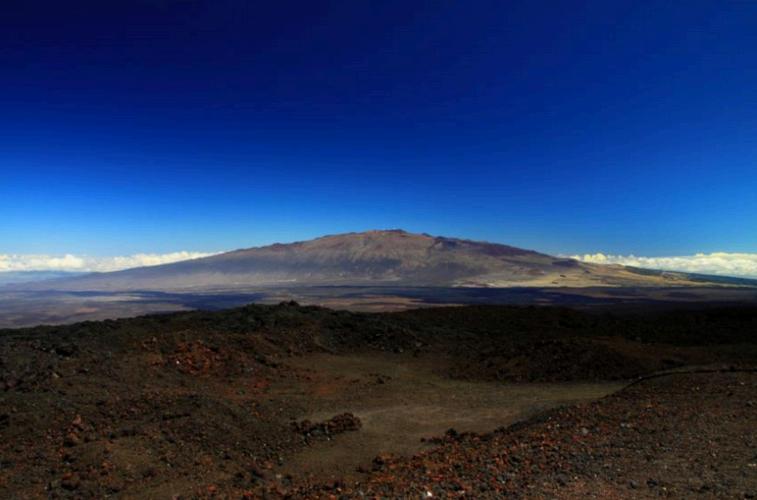
Intertwined with its cultural significance to Kānaka, Mauna Kea provides innumerable ecosystem services, hosts unique biodiversity hotspots, and supports the waterways that have provided for generations of Native Hawaiians The Mauna is home to several endangered species, endemic plants and animals, and unique ecosystems, marking its ecological significance. The environmental consequences of TMT development include water supply pollution, chemical spills and hazardous waste contamination, and native habitat destruction for endemic and endangered species. Mauna Kea’s geography also includes Lake Waiau at the peak of the Mauna, as well as an underground water reservoir. These geographies and ecosystems are part of the Kānaka’s traditional knowledge about deities, healing, navigation, and sustenance. By degrading the land itself, the TMT inherently disrupts native cultures and material means of connecting to the land.
Yet, the TMT International Observatory (TIO), which declared Mauna Kea as the final site for TMT construction in 2014, garners support and funding from many prominent academic and research institutions in the US, Japan, China, India, and Canada, including the University of California system and National Science Foundation Researchers generally view the TMT as a key “unprecedented global partnership” that “will focus the human capital, the talent and curiosity, of much of the global community.” Sanders’ article, published in the Journal of Astrophysics and Astronomy, institutionalizes the supposedly apolitical scientific view of the TMT. This view, however, glosses over the dispossession and disregard for Native Hawaiians’ culture and land, as well as the grave environmental impacts of TMT construction, making the TMT an issue of environmental politics. TIO institutions represent only a handful of Western actors that fail to depict the true global community, which includes Indigenous, Black, Pacific Islander, and other peoples who have historically been dispossessed and displaced from their native land. Evidently, the TIO and their construction of the TMT (both physically and narratively) exclude histories of US settler colonialism and exploitative
extraction in the Hawaiian islands.
To understand the depth of the struggle to protect Mauna Kea against TMT construction and all largescale development, contextualizing this case study within the history of US colonization in Hawai'i is necessary. In 1893, the United States military and Minister illegally overthrew Queen Lili'uokalani, the last monarch of the Hawaiian "crown lands," by "conspir[ing] with American and European businessmen to persuade armed U.S. forces to invade the sovereign Hawaiian Kingdom." Thus, the creation of the US “State of Hawai’i” in 1959 had always been predicated on land stolen from Kānaka Maoli. This legacy continues to materialize in the ongoing undermining of Native Hawaiians’ self-determination and ability to make decisions about their land and resources.
Since 1968, the Hawai'i Board of Land and Natural Resources (BLNR) has been the body that grants construction permits in Hawai'i, making the BLNR the primary decision maker for how Mauna Kea is managed, instead of the Indigenous communities who ancestrally belong to the land. In 1968, the BLNR granted a permit for one astronomy observatory to be built. Instead, multiple telescopes were built, and the BLNR granted construction permits "after the fact," reflecting their noncompliance with permit regulations. Further mismanagement has been evident in the numerous chemical and hazardous waste spills, including diesel, mercury, sewage, and ethylene glycol, as a result of construction. In 1998, the Hawai’i state auditor released a report detailing the University of Hawai’i (UH) and BLNR’s 30 years of mismanaging the Mauna and its natural resources This mismanagement violates the United Nations Declaration on the Rights of Indigenous Peoples, which upholds Indigenous rights to “free, prior, and informed consent,” and holds states accountable for infringing on Indigenous culture or dispossessing them of their land Overall, the bulk of land use management and decision-making power in Mauna Kea has been siloed to UH and BLNR, violating international Indigenous rights and precluding Kānaka Maoli from being primary decisionmakers in the use of their ancestral lands.
“Overall, the bulk of land use management and decisionmaking power in Mauna Kea has been siloed to UH and BLNR, violating international Indigenous rights and precluding Kānaka Maoli from being primary decision-makers in the use of their ancestral lands.”
The construction of the TMT and its disregard for Kānaka Maoli’s rights to self-determination and cultural practice exposes the intentions of the BLNR, UH, and TIO to prioritize their research agendas over the dispossession of communities Much like mass tourism in Hawai’i and its environmental and cultural consequences, TMT construction strips sovereignty from Native Hawaiians, degrades the environment, and harms cultural preservation. Matilde Córdoba Azcárate describes tourism as “predicated on commodification and extraction, use of environment, resources, labor, land...” which is similarly applicable to the issue of the TMT By extracting from the environment and reducing the
Mauna to a commodity best utilized for research, the TMT, like tourism, devastates Kānaka and their land.
The question of who can rightfully make decisions about development in Mauna Kea involves many stakeholders, namely Kānaka Maoli, the scientific community, and the local government. Some Kānaka believe the TMT would bring more educational and professional opportunities for residents. This is a minority sentiment a September 2019 poll of 400 residents showed that 27% of Kānaka supported the TMT, showing a decline in support from a March 2018 poll of 72 residents, which reported 72% support. Others condemn the construction of the TMT and all telescopes on Mauna Kea, which has given rise to grassroots and non-profit organizations that defend the Mauna. Indigenous women particularly have led the creation and continued leadership of organizations such as Mauna Kea Education and Awareness to educate communities and build solidarity among non-Indigenous activists Silvia Federici, a feminist scholar and activist, has highlighted that, in the Dakota Access Pipeline (DAPL) protests, it was mostly mothers and grandmothers who created the foundations for over 7,000 people to camp out to oppose yet another development project that destroyed and polluted Indigenous land. Indigenous women’s leadership, Federici argues, is rooted in “the power that women had in Native communities, [which is] very likely related to the latter’s lack of desire for private property and accumulation.” These women-led initiatives to protect their native lands strongly reflect Indigenous identity in the social response to the TMT.
These social responses include direct actions in 2015 and 2019, when many generations of Kānaka and allies blocked access roads and held demonstrations on the Mauna. These actions successfully stalled construction and pressured the Hawai’i Supreme Court to invalidate the construction permits, though over 30 activists were arrested in both years, most being Native Hawaiian elder cultural practitioners. These cases of misused political power drew international attention to Mauna Kea, giving rise to solidarity efforts across the Pacific Ocean. Environmental justice advocates have organized in solidarity with Mauna Kea through the University of California Divest TMT campaign, Mauna Kea Protectors chapters, and campuses (including NYU and UC Berkeley) hosting the traveling Kūkulu art exhibit to raise awareness about the TMT and petition to oppose it, which boasts almost 490,000 signatures on Change.org. In 2019, in response to this global pressure, the Hawai’i state governor declared a State of Emergency, bringing in the National Guard to detain and repress kū kia’i mauna, or guardians ofthe mountain
Violent state responses to direct actions persist in many activist movements, including the 2015 protests against DAPL in Standing Rock. During the #NoDAPL Black Friday demonstration, 33 activists were arrested. Estes, a Lakota organizer and journalist, highlights how law enforcement has been used “to demonize movements [and] paint them as insurgents.” Through these parallels between movements for land and
“Indigenous women particularly have led the creation and continued leadership of organizations such as Mauna Kea Education and Awareness to educate communities and build solidarity among non-Indigenous activists.”
sovereignty, Estes exposes how state governments and law enforcement respond to environmental activist movements through repression. This fosters harmful situations in which states use their political power to hamper movements that protect environmental justice and Indigenous rights.
In Hawai’i, in response to years of organizing efforts, the BLNR and TIO have recently shifted their approach by conducting more environmental impact assessments and garnering community input Yet, Mauna Kea protectors and allies have upheld the demand to oppose any construction on the Mauna, as it will always inherently involve the degradation of land and culture. Furthermore, heightened attention to the TMT has caused a split in the scientific community there are groups who believe this research is apolitical and "inherently nonviolent," others who barbarize Kānaka activists as from the "stone age culture," and scientists who uphold Indigenous sovereignty and oppose the TMT.
“...the issue of the TMT also is rooted in the longer project by the West to delegitimize Indigenous knowledge, which enables them to justify the stealing of Indigenous land for Western governments and academic institutions to manage.”
These divisions among the academic community, as well as the BLNR and local government's resistance to the TMT, reflect an underlying issue of agnotology, or the study of culturally-induced ignorances. Gaps in understanding of why Kānaka connect so deeply and fight so committedly for Mauna Kea stems, not from an innocent absence of knowledge, but from a longer history of “global priorities, funding patterns, institutional and disciplinary hierarchies,” and more that institutionalize Western scientific knowledge and delegitimize Indigenous knowledge and culture Since the era of European colonization, Western scientists tended to only document knowledge that they understood, and not other “worldviews, schemas of usage [of nature], or alternative ways of ordering and understanding the world.” Thus, the issue of the TMT also is rooted in the longer project by the West to delegitimize Indigenous knowledge, which enables them to justify the stealing of Indigenous land for Western governments and academic institutions to manage.
The issue of TMT construction on Mauna Kea evidently brings up deeper questions of Indigenous rights to manage their ancestral land, Indigenous collaboration with research and governmental institutions, and the ways in which we legitimize and validate (or invalidate) Indigenous knowledge. The Western colonial project to dehumanize Indigenous peoples and delegitimize Indigenous ways of living has had numerous impacts, spanning from justifying Western occupation of various lands, to some in the Western academic community having preconceived biases of Native Hawaiians as "hordes"' and "illegitimate" kahuna, or people of authority Still, many communities of Native Hawaiians, Indigenous peoples, and solidarity allies throughout the world continue to unite for Indigenous sovereignty. As Nick Estes explains in his Red Nation podcast, political grassroots organizations in Hawai’i that were originally established to fight against the US annexation of Hawai’i are now “re-emerging... to establish not just a radical politics against colonialism, but [also] capitalism, and for indigenous internationalism.” These calls for solidarity throughout the world extend not just to Kānaka
Maoli, but among all Indigenous peoples and to all colonized nations Indigenous internationalism unifies movements for sovereignty and self-determination as part of a larger effort to take collective action against the root systems of capitalist oppression, which provide the foundation for dispossession and large-scale environmental injustices. As seen through the Indigenous and primarily women-led efforts in Mauna Kea, it is through the collective power of entire communities of people, and through grassroots activism, that we can achieve sovereignty, self-determination, and liberation among Indigenous and colonized peoples.
“Indigenous internationalism unifies movements for sovereignty and self-determination as part of a larger effort to take collective action against the root systems of capitalist oppression, which provide the foundation for dispossession and large-scale environmental injustices.”
Since the Fall of 2022, I have been engaging in Mauna Kea activism efforts as part of my Environmental Justice Campaigns position in our student government Eco-Office. We did so along with other UC campuses who decided to make this a UC-wide initiative, given the complicity of the UC in funding the TMT. As someone who is not Indigenous and who only knew marginally about the TMT and Indigenous rights, I worried about taking up the campaign and how my identity and lack of knowledge might invalidate the campaign efforts I've learned a lot about the Mauna, Kānaka Maoli culture, and the TMT's impacts and funding structures since then, and chose to write about Mauna Kea for this case study to further deepen my understanding of the environmental and political issues at hand.
Through this case study, I have appreciated being able to learn and write about grassroots efforts in an academic setting. Because I was initially exposed to the Divest TMT movement in an advocacy framework, I did not know many specifics about the BLNR or the Kānaka who do support the TMT, and being able to understand their views in relation to what I believe has helped to make my understanding more holistic. This case study, my past experiences, and the discussions we held in class have helped me in an ongoing process to reframe my relationship with Indigenous land Jessica Hernández’s discussion in Fresh Banana Leaves about being simultaneously displaced and a settler has helped to shape my own ways of existing as a non-Indigenous person advocating for Indigenous sovereignty by teaching me that constant willingness to learn and correct mistakes, as well as strong respect for the Kānaka leading us, are the key tools in this work. I also found the discussions on agnotology especially relevant to this case study, as Native Hawaiians are often portrayed as anti-science due to their TMT opposition. But in these portrayals, the underlying issue
is that of how Indigenous knowledge is viewed, accepted, or ignored Understanding this issue, and questioning why Indigenous knowledge is largely ignored, is also a theme I attempted to incorporate and relate to environmental politics in this case study.
Additionally, while I did not have space to draw more parallels throughout this case study, I also see strong parallels between Indigenous sovereignty movements in Hawai'i, in the Philippines, and in Palestine. The histories of Western colonialism, ongoing projects of state repression, and strong communities that grow from these issues all tie these struggles together. While the past two months have been unprecedented, heartbreaking, and agitating, my emphasis on grassroots movements in this case study is also shaped by the strong collective organizing and community-centered optimism that we are now seeing in response to the genocide in Palestine The strengthening solidarity and joint international efforts at the most basic community level to liberate all Indigenous and oppressed peoples, to me, reflects the Estes quote: "The collective faith that another world is possible is the most important aspect of revolutionary work. It is from everyday life that the collective confidence to change reality grows, giving rise to extraordinary events." I believe that the communities we have formed to fight for environmental justice are extraordinary, and it is our commitment to changing reality and our belief in a liberated world that carries our revolutionary strength forward.
Kahanamoku et al., “A Native Hawaiian-Led Summary of the Current Impact of Constructing the Thirty Meter Telescope on Maunakea,” 2. 1. Sanders, “The Thirty Meter Telescope (TMT),” 82. 2. Nula666, View of Mauna Kea. 3.
Mauna Kea Education and Awareness, “Mauna Kea Facts.” 4. Mauna Kea Education and Awareness. 5. Sanders, “The Thirty Meter Telescope (TMT),” 86. 6. Sanders, 85.
7.
Kahanamoku et al , “A Native Hawaiian-Led Summary of the Current Impact of Constructing the Thirty Meter Telescope on Maunakea,” 3 8
50 Years of Mismanaging Mauna Kea 9
50 Years of Mismanaging Mauna Kea 10
United Nations General Assembly, United Nations Declaration on the Rights of Indigenous Peoples. 11. United Nations General Assembly, United Nations Declaration on the Rights of Indigenous Peoples. 12.
Kahanamoku et al., “A Native Hawaiian-Led Summary of the Current Impact of Constructing the Thirty Meter Telescope on Maunakea,” 4. 13.
Kahanamoku et al., 5. 14. Federici, “Beneath the United States, the Commons,” 82. 15. Federici, 81. 16.
Kahanamoku et al., “A Native Hawaiian-Led Summary of the Current Impact of Constructing the Thirty Meter Telescope on Maunakea,” 5. 17. Kahanamoku et al., 5. 18.
Mauna Kea Education and Awareness, “Kūkulu.” 19.
Mauna Kea Education and Awareness, “No Construction of the TMT Telescope on Mauna Kea.” 20. Estes, “Prophets,” 3 21
22 Estes, 3
23 US National Science Foundation, “Thirty Meter Telescope - Environmental Compliance ”
24 Kahanamoku et al , “A Native Hawaiian-Led Summary of the Current Impact of Constructing the Thirty Meter Telescope on Maunakea,” 6
25 Schiebinger, “Introduction,” 3
26. Schiebinger, “Bioprospecting,” 87.
27. Kahanamoku et al., “A Native Hawaiian-Led Summary of the Current Impact of Constructing the Thirty Meter Telescope on Maunakea,” 6.
28. Estes, “Indigenous Solidarity with Palestine w/ Uahikea Maile and Leanne Betasamosake Simpson, 36:15.
29. Estes, “Prophets,” 19.
50 Years of Mismanaging Mauna Kea, 2017. https://vimeo.com/247038723. Códoba Azcárate, Matilde. "Predatory and Sticky Tourism Geographies." In Stuck With Tourism: Space, Power, and Labor in Contemporary Yucatán, 1–27 Berkeley, CA: UC Press, 2020
Estes, Nick “Indigenous Solidarity with Palestine w/ Uahikea Maile and Leanne Betasamosake Simpson ” The Red Nation Podcast, n.d. https://open.spotify.com/episode/3Wvg6pyhiwvykZr1G8HFD8? si=8019559e2e204879.
Estes, Nick. “Prophets.” In Our History Is the Future: Standing Rock versus the Dakota Access Pipeline, and the Long Tradition of Indigenous Resistance, 1–23. Brooklyn, NY: Verso Books, 2019. Federici, Silvia. “Beneath the United States, the Commons.” In Re-Enchanting the World: Feminism and the Politics of the Commons, 78–84. Oakland, CA: PM Press, 2019.
Kahanamoku, Sara, Rosie ’Anolani Alegado, Aurora Kagawa-Viviani, Katie Leimomi Kamelamela, Brittany Kamai, Lucianne M Walkowicz, Chanda Prescod-Weinstein, Mithi Alexa de los Reyes, and Hilding Neilson “A Native Hawaiian-Led Summary of the Current Impact of Constructing the Thirty Meter Telescope on Maunakea,” 2020. https://doi.org/10.6084/m9.figshare.c.4805619.
Mauna Kea Education and Awareness. “Kūkulu.” Mauna Kea Education and Awareness, August 13, 2021. https://www.mkea.info/kukulu.
Mauna Kea Education and Awareness. “Mauna Kea Facts.” Mauna Kea Education and Awareness, October 25, 2021. https://www.mkea.info/protectmaunakea-1.
Mauna Kea Education and Awareness. “No Construction of the TMT Telescope on Mauna Kea.” Change.org Accessed December 11, 2023 https://www change org/p/gordonand-betty-moore-foundation-no-construction-of-the-tmt-telescope-on-mauna-kea. Nula666. View of Mauna Kea from Mauna Loa Observatory, Island of Hawaiʻi. September 13, 2010. Own work. https://commons.wikimedia.org/wiki/File:Mauna_Kea_from_Mauna_Loa_Observatory, Hawaii - 20100913.jpg.
Sanders, Gary H. “The Thirty Meter Telescope (TMT): An International Observatory.” Journal of Astrophysics and Astronomy 34, no. 2 (June 1, 2013): 81–86. https://doi.org/10.1007/s12036-013-9169-5. Schiebinger, Londa. “Bioprospecting.” In Plants and Empire: Colonial Bioprospecting in the Atlantic World, 73–104. Cambridge, MA: Harvard University Press, 2004.
Schiebinger, Londa “Introduction ” In Plants and Empire: Colonial Bioprospecting in the Atlantic World, 1–12 Cambridge, MA: Harvard University Press, 2004
United Nations General Assembly United Nations Declaration on the Rights of Indigenous Peoples, A/RES/61/295 § (2007) https://documents-ddsny un org/doc/UNDOC/GEN/N06/512/07/PDF/N0651207 pdf?OpenElement
US National Science Foundation. “Thirty Meter Telescope - Environmental Compliance.”
US National Science Foundation, November 9, 2023. https://new.nsf.gov/funding/environmentalcompliance/thirty-meter-telescope.
For GEOG 138, Global Environmental Politics, Prof. Diana Negrín, Fall 2023
SCEC is a healing space for students of color to seek refuge from Whitedominated environmental spaces, learn more about the intersections of environmental and social justice, and raise conversation about environmental racism and justice on and off campus.
Learn about EJ
We have multiple projects and media campaigns centered around environmental justice (EJ), helping to raise awareness on campus and beyond.
We offer resume support + connect you with our network of alumni/BIPOC environmental professionals. Every spring, we also facilitate a Mentorship DeCal with CNR!
If you self-identify as a person of color, this is a space for you to connect and find friends in the environmental field + share thoughts, experiences, ideas, and resources.


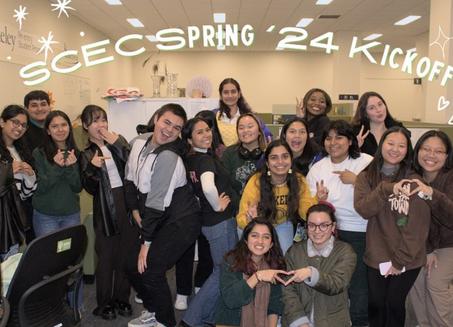
socenvcollective@gmail.com @scecberkeley

Among SERC’s multiple volunteer-based membership teams is our EOC Team! Working closely with the Community Resilience Associate @ SERC and SCEC, members will have the opportuntiy to plan events and work on social media content related to SCEC’s #OurEnvironmentalism campaign.

serc.berkeley.edu @sercberkeley
SERC Book Club is a community resource formed in response to a need for environmental education that 1) centers on the experiences of BIPOC with environmental and social injustices 2) equips us with the bold imagination and optimism necessary to address the crises of our times.

